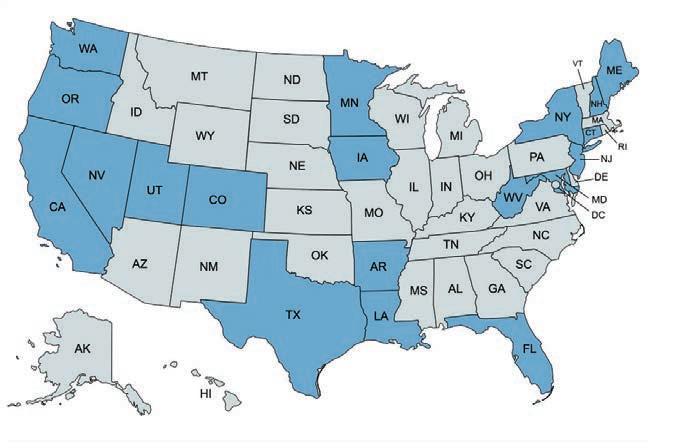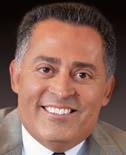GR land bank is one step closer
State House lawmakers passed a bill that would give Grand Rapids and six other Michigan cities the power to form their own local land banks.



State House lawmakers passed a bill that would give Grand Rapids and six other Michigan cities the power to form their own local land banks.


Several West Michigan counties are bucking overall statewide population trends, pointing to the region’s comparative prosperity even as the state as a whole faces a period of stagnation.
Citizens Research Council of Michigan and Ann Arbor-based Altarum issued research this month that o ered a look at statewide population and demographic trends. While the research based on long-term outlooks from the University of Michigan expects the state’s sluggish growth trend to persist, it also projects accelerated growth for several counties in the West Michigan region.
Among them are Kent, Ottawa,
Population growth rates in Kent and Ottawa counties have exceeded the state’s, a trend that’s projected to continue. Here’s a look at population trends and outlooks for both counties, according to a needs assessments conducted by Housing Next.
By Kate CarlsonHouse Bill 4375, sponsored by state Rep. Kristian Grant, D-Grand Rapids, on May 18 passed 57-50 with minimal GOP support. Some House Republicans previously raised concerns that the bill would cause duplicative functions in certain cases if a city and its county operated separate land banks.

As proposed, the bill would expand Michigan’s land bank law to allow any city with a population of at least 50,000 people to create a land bank authority, as long as the city is not in a county that already operates a land bank. Forty-eight of Michigan’s 83 counties operate a county land bank.
“We are in a housing crisis, and we need to create pathways for local entities to create a ordable housing
Allegan, Montcalm, Kalamazoo, Barry, Newaygo and Ionia counties. ey’re all part of a corridor stretching across the southern

A Grand Rapids-based maker of Mexican-inspired cold brew co ee hopes to learn best practices for scaling the brand for national growth as part of a new cohort in retailer Target Corp.’s accelerator program.
Soldadera Co ee LLC is one of only 10 brands nationwide accepted into Target’s third cohort in its Takeo Food and Beverage
program.
e accelerator takes small businesses through six weeks of virtual training in group working sessions and one-on-one meetings to help grow their understanding of the ins and outs of retail and sales while helping brands hone their marketing skills.
Soldadera Co ee CEO Mario Rodriguez-Garcia said another small business owner encouraged him to apply for the program to help the company increase its retail presence.
See SOLDADERA on Page 28
PAGES
After dissolving in 2018, the Kent County Land Bank rebranded as InnovaLab to focus on modular housing projects. | COURTESY OF INNOVALAB






|
By Margot AmouyalSmall businesses using Blue Cross Blue Shield of Michigan and Priority Health for employee health coverage face moderate rate increases next year.
For policies that renew Jan. 1, 2024, Grand Rapids-based Priority Health proposes to increase premiums for HMO and point-of-service plans by a statewide average of 6.7 percent, and 6.3 percent for PPO plans, according to rate filings to state regulators.
Blue Cross Blue Shield submitted a rate request to the Michigan Department of Insurance and Finance Services for a 4.9 percent statewide average increase in 2024 for PPO plans. HMO subsidiary Blue Care Network proposed a 5.5 percent increase for small businesses with 50 or fewer employees.
A prominent downtown Grand Rapids concert venue has reversed course with its public mural competition by agreeing to pay artists for their work and changing its licensing rules.

Announced in March, GLC Live at 20 Monroe’s art competition that sought a new mural for its building exterior generated significant community backlash when the earliest prizes involved free concert tickets. The initial rules also would have entitled the venue, which is owned by entertainment giant Live Nation Entertainment, to have temporary exclusive licensing rights to the
artists’ submissions.
While the roughly 2,000-capacity venue has since revised the competition rules twice in recent weeks, artists say the incident serves as an example of a company taking advantage of artists without compensating them financially. As well, some local arts leaders are calling for a dedicated platform
that helps connect artists with businesses seeking artistic pieces.
The competition asked Michigan artists to submit designs for the staircase outside of GLC Live at 20 Monroe.
Contest rules initially outlined that all Michigan artists who submit designs — regardless of whether they win — allow GLC
Live at 20 Monroe to exclusively use, reproduce, exploit, modify, publicly display and create derivatives of their art in any way for the next two years without further compensation.
The venue then amended the rules to remove the exclusive licensing period, added a $500 cash prize alternative to the concert tickets and extended the submission deadline by seven days.
GLC Live then changed the rules again by increasing the reward to a $2,500 cash prize, in addition to the select concert tickets.
“We are feeling very good about the rates we’re bringing to the market considering the dynamics we’re seeing with trends in general,” said Sandy Fester, vice president of Michigan business at Blue Cross Blue Shield. “We think the rating actions are appropriate and still moderate.”
Blue Cross Blue Shield has more than 20,000 small businesses with an excess of 283,000 people enrolled on small group HMO and PPO policies.
Rate filings from both companies, which control most of the health insurance market in West Michigan, propose increases that are similar to what state regulators approved in 2022 for 2023 policy renewals.
American Seating Co. is preparing to leave its sprawling headquarters and manufacturing complex on the West Side for another location in the city, Crain’s Grand Rapids Business has learned.

Executives confirmed that American Seating Co., which was founded in 1886 and has maintained a large albeit shrinking
headquarters and manufacturing presence on Grand Rapids’ west side, will soon announce a relocation plan to an existing site in the city. The company said it expects to make a formal announcement in the coming weeks.
Visible from nearby U.S. 131, American Seating’s large manufacturing plant sits on nearly 17 acres at 901 Broadway Ave. NW, just north of the mixed-use American Seating Park at 801 Broadway, which includes the company’s 33,000-square-foot office space, other businesses and housing.
The company’s relocation plan involves renovating an as-yet-un-
disclosed existing manufacturing space in the city. The renovation will occur in phases over the next year with an anticipated completion date by early 2024, according to a company spokesperson. Future plans for the nearly 17-acre property at 901 Broadway have not been disclosed.
“Founded in 1886, we’re proud not only to be staying in Grand Rapids but also investing in our company’s and the region’s future as we continue our 137-year legacy of designing and manufacturing quality transportation seating
See SEATING on Page 28
Local artists want more control over their own work in mural contest
“It is disheartening to see organizations that are in the arts turn around and then have such little perceived respect for artists.”
Dania Grevengoed, a Grand-Rapids-based muralist
INSIDE: Changes in place this spring aim for solutions, accountability from utility companies. PAGE 6
OPINION: Consumers Energy outlines its plans to increase grid reliability; technology needs to play a role in change; utilities should be doing more. PAGES 7-8
| BY DAVID EGGERT, CRAIN’S DETROIT BUSINESSDenise Graves had had enough.
After losing power for four days when high winds swept through Brighton Township in late summer, the latest in a string of outages since she moved into her home six years earlier, the DTE Energy customer “bit the bullet” and bought a whole-house generator for $10,500.

No more carrying water to ush the toilets. Or showering and working at a friend’s house. Or nding a place to store food. Or running out to buy dinner, co ee and ice. Or worrying about the dog if she is out of town.
Before the generator was installed, she lost electricity two more times, including during an ice storm. All told, there were 13 outages — nine sustained and four temporary — in about 15 months.
“I understand things happen: weather, trees, animals,” said Graves, who has complained to the state attorney general’s o ce and to legislators. “However, they are a utility company and should be held accountable for what they should be doing, keeping the electricity on.”
She is not alone.
Perhaps at no other time have Michigan’s two dominant and politically in uential power companies, Detroit-based DTE and Jackson-based Consumers Energy, been under as much public scrutiny as now. e heat is coming from all corners and seems unlikely to wane for several reasons.
An unprecedented outside review of the utilities’ distribution systems is underway after fed-up state regulators agged their “concerning” performance. Alarm bells are blaring over the grid’s resiliency against increasing and worsening extreme weather events spurred by climate change. e transition to electric vehicles is raising the stakes to curtail disruptions. And a pending rewrite of Michigan’s energy law is attracting interest as a path toward reforms.
As with other aging infrastructure — roads, water mains and dams — the grid needs years of attention and billions of dollars in upgrades and maintenance. e x will not be quick, though. Nor will it be cheap in a state where electricty rates are higher than many.
e utilities, which serve about 4.1 mil-
lion, or 88% of households, businesses and others statewide, are trying to reassure frustrated customers and critics who say they have been too pro t-driven at the expense of reliability.
“While we’ve been getting better in recent years, we know we have a ways to go,” said Matt Paul, DTE Energy’s executive vice president of distribution operations. “We’re
not where we need to be. We get that. But we also want folks to know we have a plan. We’re working the plan. It’s not all going to happen overnight, but it’s the right plan.”
How Michigan stacks up
Michigan ranks poorly on reliability performance, regardless of whether major U.S.
Outages have plagued Michiganders for years — what will it take to stabilize the grid?
weather events — like ice storms, hurricanes and wild res — are factored in. e most recent year for which data is available is 2021, when August storms left about 1 million customers without power, some for more than a week.
Customers on average had no electricity for 873 minutes, sixth highest in the U.S. e average number of outages per customer was 1.6, 12th most. e average time to restore service was 527 minutes, third worst.
When discounting major event days, such as severe storms, Michigan mostly still performed badly. Each customer, on average, was without power for 178 minutes, third highest, and had just over one outage per year, tied in the middle of the pack at 24th most.
e time to bring back electricity was 173 minutes, second worst.
Reliability has been a problem for years.
e Citizens Utility Board of Michigan, which advocates for residential energy customers, annually reports how the state is faring against others. Michigan’s average outage duration has improved modestly since the federal government began collecting reliability data a decade ago, “but this was from a very poor baseline, which is why Michigan’s (duration) scores are still some of the worst in the country,” the group
said in its most recent report.
“Ultimately it’s deferred maintenance by the utilities over the years and lack of cost-e ective investment in the grid to maintain it,” executive director Amy Bandyk said. “It has been happening for decades, and we’re seeing the results of that lack of investment and maintenance.”
One vital step is to keep power lines free from tree branches and other vegetation. at can prevent outages in the rst place, or at least limit their impact and duration.
In DTE’s service territory, which
includes metro Detroit and the umb, trees cause two-thirds of outage minutes and half of outages.
Both major utilities are playing catch-up on tree trimming. Consumers, which serves much of the Lower Peninsula, used to trim along 50,000 miles of low-voltage lines on a 14-year cycle, which was not best practice. It is changing to a seven-year rotation and is roughly 55% of the way there.
Also, the company this year began trimming “smarter” by using an analytics model, including satellite images and information about where trees are growing and dying. It reports being 50% more
e ective at predicting and prioritizing high-risk areas.
“It used to be about getting more miles. Now it’s about getting more miles and getting the right miles while you’re at it,” said Greg Salisbury, Consumers’ vice president of electric distribution engineering.
DTE is switching to a ve-year rotation and is 80% done.
“Until they catch up on that, they will continue to have this problem,” said energy policy expert Douglas Jester, who is managing partner at 5 Lakes Energy, an East Lansing-based consulting rm. A lack of trimming not only increases outages, he said, but re-

sults in longer repair times that delay the return of electricity.
“Tree trimming is the thing that can have bene ts fastest,” he said. “Anything else that you do, if it’s replacing wires or poles or undergrounding or any of those other grid-hardening things, it’s going to take 20 or 30 years to work through the whole system. It’s both economically and physically not possible to do it fast. So we’ve been emphasizing tree trimming because it’s the way we can get the most rapid improvement and then everything else can be worked at at whatever pace we think we can a ord.”
Dan Scripps chairs the Michigan Public Service Commission, which regulates many of the state’s utilities and sets the rates they charge.
“Where the trees have been trimmed, we’ve seen improvements,” he said. “But the systems are big. It’s taking a while to do some of that catch-up to get us onto a more regular tree-trimming cycle that gives better reliability performance.”
In the past, the utilities did not spend all of what was authorized for trimming, and some of the money went toward other unexpected expenses like storm restoration.
See POWER on Page 6
There has been much attention surrounding secrecy in politics, from federal nonpro t and corporate accounts that keep speci c donors and expenses secret to the fact that the state legislature and executive of ce are not subject to the Freedom of Information Act.
When it comes to transparency, unfortunately, there has always been a difference between the goose and the gander, even in health care. The privacy pharmaceutical companies are afforded in setting drug prices is enough to make even politicos jealous.
Nearly every aspect of health care in Michigan is subject to state regulations and disclosures, except for drug manufacturers and their prescription drug prices. Health plans are state-licensed, and state regulators review and approve their policy premiums annually. Providers like physicians and specialists are also state-licensed; their scope of practice is statutorily dictated in Michigan law and enforced by state regulators. In 2021, the Hospital Price Transparency initiative went into effect, providing public access to negotiated prices for health care services at each hospital. And most recently, Michigan enacted PA 11 of 2022, the Pharmacy Bene ts Manager (PBM) Licensure and Regulation Act, allowing for greater public transparency and regulators to review PBM conduct with pharmacies.

Meanwhile, even though nearly a quarter of every dollar spent on health care is attributed to prescription drugs, drug manufacturers are not licensed by the state, nor are their drug prices reviewed by state regulators. Heck, they don’t even have to raise their hand and tell anyone when they decide to spike prescription drug prices on customers. Information on impending price increases is often learned only by listening to Wall Street investment earnings reports and projection calls. Because of this lack of transparency, drug manufacturers are about to hike covid vaccination costs on insurers by nearly 4 to 5 times greater than what they’ve been charging the federal government.
For years, policymakers have attempted to control prescription drug costs by imposing cost-sharing and utilization controls on state-regulated health plans. These efforts have only aided unregulated drug manufacturers and exacerbated the skyrocketing costs of prescription drugs.
According to the U.S. Department of Health and Human Services, prescription drugs are more than 2.5 times higher than in other similar high-income nations. The Centers for Medicare and Medicaid Services (CMS) has reported that prescription drug spending is projected to outpace growth in all other major healthcare sectors, averaging 6.1% annually through 2027.
The federal government has begun to allow states to hold drug manufacturers accountable. States can require drug pricing transparency reports from drug manufacturers when they increase prescription drug costs. They can also establish prescription drug affordability review boards and create importation programs to help health plans access more affordable prescription drugs for their customers.
Representative Samantha Steckloff (D-Farmington Hills) has introduced House Bill 4409, which requires drug manufacturers to inform the state of Michigan when they increase a prescription drug cost beyond 15% annually. Similar legislation shining a light on high costs drug prices have been enacted in 19 states.
The states in dark blue represent the 19 states that have passed drug transparency legislation.

Gathering information on drug pricing in Michigan is the rst step to making wise future policy decisions on combating the prescription drug cost problem. As has been said before, sunlight is often the best disinfectant.
As state leaders contemplate ideas for addressing political secrecy, the transparency desperately needed for the goose (drug manufacturers) might also be best for the gander (politicos).
electricity prices, 2021
For the first time in nearly 20 years, Michigan regulators this spring updated service quality and reliability standards for power utilities, including DTE Energy and Consumers Energy.

The rules lowered the threshold for what is considered unacceptable performance during outages, and boosted bill credits for customers who go without electricity and made them automatic. They previously had to apply and rarely did.
The new rules capped a 3½-year regulatory process. A look at the changes:
Credits
Residential customers used to be able to apply for $25 if they lost power for at least 16 hours in a “normal” outage, when up to 10% of customers were out, or at least 120 hours in a “catastrophic” out-
From Page 5
“There certainly have been instances where the dollars that we thought were going to reliability improvements were used for other valid purposes but for purposes that didn’t ultimately improve the reliability of the system,” Scripps said. Now, he said, the companies’ vegetation budgets are “ringfenced,” a regulatory tracking mechanism that “gives us a higher guarantee that the work is actually going to get done.”
While the surge in line clearing should help, the grid also needs to be modernized. DTE, for instance, says its system is one of the country’s oldest. Parts were built in the early 1990s, when Detroit became an industrial powerhouse.
“It’s sort of at that point of the life cycle where we really need to aggressively rebuild it,” Paul said.
Two-thirds of DTE’s 45,000 miles of mostly distribution lines are above ground. The company plans to convert the older, lower-voltage half of the system — called 4.8kv — to 13.2kv so it can deliver more power, including for EV chargers. New poles, crossarms and wires are bigger, stronger and better able to withstand harsher weather, too, he said.
The ice storm that struck in February, which was described as the worst in 50 years, brought ice as thick as three-quarters of an inch, leaving 860,000 customers without electricity. While an event like that would have significantly damaged any grid, Paul said, the older sections were hit harder. Places where tree trimming and poletop maintenance had been done experienced 30% to 50% fewer outages.
age, when 10% or more lost power.
Now they qualify for $35 automatically if they lose power for at least 16 hours in normal conditions, 48 hours in “gray sky” conditions — a new category — and 96 hours in catastrophic conditions, plus $35 for each additional day. Gray sky is defined as when more than 1% but fewer than 10% of
“Assumptions underlying the grid have changed,” Scripps said, saying natural disasters once seen as exceptions are now occurring almost every year. “We’ve got to make sure that we’ve got a grid that’s ready for it.”
Automation, the hardening of the grid with high-tech gadgets, is key. The utilities have installed thousands of line sensors to detect and pinpoint anomalies that can be addressed before they become outages. They also are affixing more automatic transfer reclosers to poles. The devices help prevent interruptions by rerouting power to another circuit.
“The more devices we have out there, the more we’re able to more granularly isolate those outages and impact fewer and fewer customers,” said Paul, who said DTE has fewer of them than many utilities in coastal states that have been confronting harsh weather for decades. Its goal is to add 10,000 automated devices to the field in the next five to six years.
Burying lines underground is a way to shield them from wind and ice during catastrophic storms. It has been routine for some 50 years in new subdivisions and other new construction. But much of the grid is aboveground. “Undergrounding” wires is rare because it is costly, disruptive and not foolproof.
The utilities and regulators, though, are reconsidering the feasibility as they target climate change resilience. It may make sense financially in heavily forested rural areas when stacked up against other grid-hardening work like putting in extra-large poles and wires and trimming more often than every seven years.
“We’ve gotten to the point where we think we can do it for about the
mum bill amount and the number of days they have no service. The credit amounts had been unchanged since 2002. They are not intended to make customers whole but do provide a disincentive for utilities to not respond to outages quickly, according to the Michigan Public Service Commission.
customers are without electricity. Customers with repeat outages, more than seven in 12 months, previously qualified for $25. Now it is $35 for six or more interruptions in 12 months.
The $35 credits will increase every year to reflect inflation. Commercial and industrial customers get a credit based on their mini-
same price. We can go underground or we could do all this crazy aboveground stuff,” said Salisbury, of Consumers.
In its next rate case, the company will propose doing 10 to 20 miles of selective undergrounding “that we believe is the necessary step for areas that are really at risk for these resilience events,” he said. Of Consumers’ 50,000 miles of primary, low-voltage circuits, about 5,000, are “great targets” for undergrounding. The utility this year plans to bury 2-5 miles of lines to analyze and show “how good can we get the cost,” he said.
DTE’s Paul said the per-mile cost will be much lower in rural areas than in densely populated urban communities, “but frankly, some of these areas like Detroit, we’re also looking really hard there.” He noted the potential for lowering costs by coordinating with DTE’s gas subsidiary and municipalities on work to rebuild gas mains, roads and water pipes. Burying the grid is very much a pilot project for now. But infrastructure policy experts say Michigan should be doing more to better enable it.
In a recent report for the nonpartisan Citizens Research Council of Michigan, research associate Eric Paul Dennis said undergrounding costs could be substantially reduced with “dig-once” construction, but it will not advance without a coherent state policy.
“Such policy is a prerequisite for Michigan’s urban infrastructure to become more reliable, resilient, and efficient,” he wrote. “If additional dig-once policy is not established, Michigan’s various public utilities and infrastructure agencies will continue to pursue uncoordinated independent priorities in a wasteful and inefficient manner, with avoidable costs such as frequent power outages imposed
being guarded by a first responder. It went from 240 minutes at least 90% of the time to 120 minutes in metropolitan areas and from 360 minutes to 180 minutes in non-metropolitan areas.
Utilities in the past were supposed to restore power to at least 90% of affected customers within eight hours during normal conditions and 60 hours in catastrophic conditions. Now it is eight hours when up to 1% have no power, 24 hours when more than 1% but fewer than 10% are out and 48 hours if 10% or more customers are without power.
Utilities now have less time to respond to a downed wire that is
upon all Michigan citizens and the economy.”
It is unclear to what extent, if any, legislators may directly tackle the outage problem. But majority Democrats’ desire to require that more electricity comes from renewable sources could open the door to other revisions in the energy law.
Rod Williamson is executive director of the Association of Businesses Advocating Tariff Equity, or ABATE, an interest group for two-dozen of the state’s largest energy-using companies. The manufacturers are served more by the high-voltage transmission system and are not as affected by outages. Still, there are “some fundamental problems around how the utilities get to collect cost and a lack of accountability for not spending those dollars to make sure that they have upgraded and done the appropriate preventive maintenance on their distribution systems and on their systems as a whole,” he said.
Williamson said lawmakers who have held hearings to point fingers at regulators and utility executives should instead look at laws their predecessors passed, especially a major 2008 rewrite that “swung the pendulum as far as energy policy goes in a direction that was so favorable to the utilities that we’re now seeing the results of that.”
The utilities successfully lobbied to base rate requests on projected costs and revenues rather than actual costs and revenues, which had been the process for more than 60 years. The change has resulted in higher rates and enabled the utilities to pay bigger dividends to shareholders instead
The rules now say it is “unacceptable” if, through 2029, more than 6% of a utility’s customers experience four or more outages in a calendar year. Starting in 2030, not more than 5% of customers can have four or more outages in a year.
DTE and Consumers, the state’s largest utilities, must disclose new information in their annual reports to regulators. That includes the number of customers with four or more outages and the 10 worst-performing circuits for the frequency and duration of outages.
of issuing refunds to customers, he said.
“In any business, any projection is hard to get correct,” Williamson said. “But when you also set up a system where if they project high, they’re rewarded from that financially because there’s no true-up process? That makes it even worse.”
The ringfencing of tree trimming, he said, is a “Band-Aid” so “why not fix the entire process?” He and other critics of the rate-making system say the companies get a guaranteed rate of return for their capital investment, but there generally is less incentive to spend on operations and maintenance.
In a 2018 report, the Public Service Commission said under traditional regulation, the levels of sales and capital expenditures primarily drive utility earnings whereas performance-based regulation can optimize total spending regardless of whether it is operational or capital in nature.
Regulators in April issued an order for staff to create a workgroup and report back by year’s end on potential utility financial incentives and penalties tied to the grid’s reliability. Performance-based regulation would “modify the way that utilities make money to try to bring it more in line with customer goals, customer expectations,” Scripps said.
“We’re not where we need to be. We get that. But we also want folks to know we have a plan. ... It’s not all going to happen overnight, but it’s the right plan.”
— Matt Paul, DTE Energy

Consumers Energy’s No. 1 job is to keep the lights on for our customers. The bad news is that, for too long, we and many of our customers have not been satisfied with our performance. And after the February ice storms, we know customers are asking for a stronger and smarter power grid.
This past winter, hundreds of thousands of Michiganders lost power after a series of ice storms wreaked havoc on Michigan’s electric grid, with a large number of residents remaining in the dark for a week or more.
Unfortunately, outage events like this are all too common in Michigan. In just the last several years, Southeast Michigan has seen the largest-ever storm related outage in 2017, the worst-ever summer storm season in 2021, and this last storm, the most expensive on record.
But Michiganders aren’t interested in storm trivia. Rather, it’s increasingly clear that the range of weather conditions that has historically served as the basis for how we plan our grid no longer holds. North American Electric Reliability Corp. CEO Jim Robb summed up the challenge at a recent meeting of state utility regulators when he noted: “In an era of a changing climate, looking in the rearview mirror doesn’t help.”
Indeed, the pace of climate change dictates that storm events will likely become only more frequent and severe.
Regardless, electricity customers have a right to expect their utilities to anticipate extreme weather events, provide a hardened grid that can withstand extreme weather, and be prepared to restore power expediently when the grid fails.
These expectations are a driving force behind much of the work of the Michigan Public Service Commission. Earlier this year we completed the first updates to our regu-
lations governing service quality and reliability in nearly 20 years. These updates include holding utilities to higher reliability standards and increasing the credits customers receive during power outages. Last year we initiated a first-of-its-kind engineering audit of the Consumers Energy and DTE Electric distribution systems, and we also recently launched a new effort to better align how utilities make money with the results their customers expect.
At the same time we’re working to address the immediate challenges from power outages in Michigan, we also know that the growth of electric vehicles and the potential for electrifying other end uses from home heating to industrial processes make the reliability of the electric system more important than ever.
Put simply, as we rely on electricity for an ever-expanding list of needs, we need a grid that can keep up.
Fortunately, the same EVs that add to demand on the grid are also poised to play an important role in improving its resilience. Both Ford Motor Co. and General Motors now have EVs on the market that offer vehicle-to-home bidirectional charging, providing either emergency or whole-house backup power when the grid goes down. Using the same interconnectivity technologies and communications protocols that power the Internet of Things, a growing array of customer-centric resilience solutions increases the ability of utility customers to not just to ride out power outages, but also
improve the performance of the grid for all of us.
To keep pace with these changes, the commission has also updated the interconnection rules that govern how distributed energy resources connect to the grid. And last year we overhauled our organizational structure to reflect broader changes taking place in the energy industry, including greater focus on distribution grid planning and energy forecasting.

All of this gives customers more control and more options in the short term even as we continue efforts to rebuild the grid to meet the demands of both today and tomorrow.
In 1947, and again in 2005, the Gallup polling organization asked Americans for their views on the greatest invention ever made. In both cases electricity topped the list. Today, as Ford, GM and others continue to electrify the transportation sector, as heat pumps, arc furnaces and other developments are poised to transform everything from home heating to steelmaking, the electric grid is ever-increasingly central to modern life. Given this reality, we simply cannot afford the frequency and duration of power outages we have seen in recent years. We need a “reliability-plus” approach that addresses chronic reliability challenges while ensuring we’re preparing for an electrified future. By combining traditional grid maintenance practices with advanced technologies that unlock still more value from EVs, batteries and other distributed energy resources, we can make the grid smarter and more automated.
Most important, we can build a more reliable grid for all of us, now and for the future.
Consumers Energy is accelerating our efforts to make our grid more reliable with one goal in mind: Reduce the number and length of power outages.
The good news is we have made progress. In 2022, there were nearly 20% fewer customer outages after making significant upgrades to the electric grid and completing more than 2,000 electric projects. Moving forward, we have plans to do much more.
Our approach to prevent and respond to outages is a threephased effort:
We are investing more than $100 million annually in tree-trimming efforts, nearly doubling what we were spending in 2018.
In Michigan, fallen trees or broken limbs are the reason behind a power outage about onethird of the time, making them the leading cause of outages.

We know that traditional tree trimming is still the most effective way to prevent and shorten power outages and improve system reliability.
For the circuits we cleared in 2021, we saw a 62% reduction in tree-caused outages.
We know that portions of Michigan’s high- and low-voltage distribution network are aging. We’re making investments to replace or rebuild poles, wires and substations. In 2022 alone, we replaced 10,000 poles and upgraded 100 substations. We also inspected the 50% worst-performing circuits on our distribution system and found and fixed more than 1,500 assets prior to the summer storm season.
We also hear customers asking, “Why don’t you just bury the lines?” We’re looking at that. Burying more power lines requires a careful approach, and we need to be strategic about which locations are best suited.
It is not the right decision for ev-
ery circuit.
Historically, cost has been a major barrier to undergrounding our infrastructure. As technology improves, the cost to bury lines continues to decrease. Undergrounding can be more expensive up front. But as weather patterns change, severe storms become more frequent.
So, we are reevaluating how we analyze the costs and benefits of undergrounding certain circuits. We developed a pilot proposal filed with the Michigan Public Service Commission to help answer some of these questions and help us evaluate where strategic undergrounding makes sense.
We’re designing a cutting-edge electric distribution system made for the 21st century, embracing automation and technology to help us both prevent and respond faster to power outages impacting our customers.
We recently announced plans to install 123 new automatic transfer reclosers or ATRs in 2023 to help prevent power outages and improve electric reliability for customers.
ATRs are cutting-edge devices that isolate problems on electric lines and transfer power automatically. This technology improves public safety and reduces the number of customers affected by outages. Consumers Energy has nearly 470 of these 800-pound devices currently on the electric system. The 2023 ATR deployment plan will target areas that have been most impacted by outages over the past several years.
ATRs make a real difference. For example, in a storm at the end of August 2022, the ATRs saved 8,645 customers — including 770 businesses — from losing power. In all, ATRs saved thousands of families and businesses from losing power during last summer’s storm season. Looking ahead, we will continue to be aggressive with our installation of these devices.
Our goal with these three strategies is simple: fewer, shorter and less frequent power outages for our nearly 1.9 million electric customers. The communities we serve are counting on their power being on — and we have the plan to deliver a brighter future for Michigan.

Some of the worst power outages in Michigan history came this February. With winter in the rearview mirror, summer thunderstorms — historically, perhaps the biggest cause of power outages — are looming.
cases before the MPSC.
Amy Bandyk
is executive director of the Citizens Utility Board of Michigan, which is a nonpartisan, nonprofit organization whose members are individual residential customers of Michigan’s energy utilities.
DTE Energy and Consumers Energy, the major electricity providers in the state, have been getting ready for more outages — but not in the way their customers want or need. The utilities are trying to create a narrative that pushes back against the drive to hold them accountable through strict new laws being proposed in Lansing that would put in place penalties for poor utility service. In service of that narrative, the utilities’ statements to the public and lawmakers in the aftermath of the outages this winter have shown a pattern. They have obfuscated the causes of the power outages, downplayed their role in the underlying conditions that made the grid so vulnerable in the first place and put forth solutions to reliability that the utilities themselves have failed to implement despite years of warnings from watchdog groups.
The record needs to be set straight because the Michigan Public Service Commission, the state body responsible for regulating utilities, is about to kick off a review of potential rules that would impose financial incentives and disincentives on utilities tied to their performance, creating a system of
carrots and sticks to push utilities to improve electric reliability. DTE and Consumers Energy will likely want as many carrots and as few sticks in place as possible.
So let’s break down the narrative the utilities have been crafting to influence that upcoming review.
At a Michigan House hearing in March investigating the outages, representatives of DTE and Consumers were quick to focus on how much worse the weather has become.
“What’s clear is that the weather has changed,” DTE Electric President and COO Trevor Lauer said in his testimony at the hearing. “What used to be referred to as a once in a decade or once in a century storm now is coming on a regular basis.”
What could be more out of human influence than the weather?
The problem is that scientists have been warning for many years that the climate is changing, increasing the frequency of severe weather events like thunderstorms that down power lines. Utilities have known for a long time that they need to prepare, but Michigan utilities are far less prepared than others.
Federal data on electric reliability shows that power outages in Michigan have, for years, been much lon-
ger in duration on average than those in most other states, including much longer than those in neighboring states that face similar weather patterns. For example, the average time to restore power following an outage was two hours and 36 minutes in Michigan in 2020, compared to around two hours in Ohio, Indiana and Wisconsin (see the Citizens Utility Board of Michigan’s annual Utility Performance Report for more comparisons).
Next, the utilities demand that we trust them to fix the problem. But despite repeated warnings, the utilities themselves allowed the problem to get this bad by failing for years to implement needed grid maintenance. That is clear even by the utilities’ own admission. Using the company’s own words from public regulatory filings, DTE has allowed a “backlog” of tree trimming projects to build up.
“We are playing catch-up,” Consumers Energy Vice President of Operations Chris Laird said during the March hearing, noting that while the company is now trimming 7,000 miles of vegetation a year, until recently it was only trimming 5,000 miles.
It takes years to catch up to a consistent and frequent trimming cycle. In the meantime, there are
overgrown areas where tree branches threaten power lines and customers are left to suffer with outages like the one in February, where trees felled by ice and snow were the main culprit of the widespread blackouts.
Finally, despite all those failures, the utilities now say they have a solution: give the utilities free rein to jack up customer rates to pay for hardening the grid. “The answer to this is to invest in the system,” Lauer said at the hearing.

Our aging electric grid does indeed need more investment. But it needs the right kind of investments, ones that deliver value while minimizing the impact on customers who already pay the highest rates in the Midwest. Again, history shows that Michigan’s investor-owned utilities are not trustworthy stewards of ratepayer dollars when it comes to investing in the grid. Both major utilities have overlooked the cost-effective measures that deliver the best return on investment in terms of shortening power outages in favor of unnecessarily expensive equipment replacements that deliver a bigger return to their shareholders, as shown in expert witness testimony submitted by the Citizens Utility Board in recent rate
For example, take the issue of automated technology to improve grid performance, which both DTE and Consumers Energy said in the hearings that they were embracing. “We need to automate systems. We have been on an automation strategy at DTE for five years now,” Lauer said. But in a recent rate case, the Citizens Utility Board urged DTE to adopt one of the most sophisticated forms of grid automation: distribution fault anticipation technology, which consists of software that analyzes electronic signals from distribution circuits and then detects signatures consistent with equipment failure, thus allowing grid operators that adopt the technology to act to prevent outages before they occur.
In contrast to the image it is portraying of going all in on automation, DTE ignored the Citizens Utility Board’s request to hold a pilot program investigating the use of this technology. The likely reason is that this software, while promising to improve reliability, is not particularly capital-intensive. But capital-intensive projects are how investor-owned utilities like DTE and Consumers make money for their shareholders. Built into the rates we all pay to the utilities is a return on the amount of capital the utilities invest. That return is essentially profit for utility company shareholders.
All publicly traded utilities are motivated by the drive to deliver return for shareholders, so it is no surprise that DTE and Consumers focus on expensive investments over those that are cost-effective for customers.
Michigan’s electric utilities need fundamental change that aligns financial incentives with better performance for customers. We have ideas on how to make those changes. But it’s up to all Michigan ratepayers to not believe the false narrative and push for real change.
The state is calling in outside help after determining that DTE Energy and Consumers Energy have not significantly improved outage prevention and restoration when compared to peer utilities, despite a series of regulatory orders following big storms over the past decade.
A third-party audit of their distribution systems, including all equipment and operations, is expected to begin soon per an order issued last fall by the Michigan Public Service Commission. The review will consist of two parts.
One will determine whether installed infrastructure matches each company’s records and com-
pare the condition of the distribution system to that of other utilities in similar climates.
The other will gauge whether emergency preparedness, storm restoration, maintenance and spending programs are sufficient and equitable, and whether they properly plan for climate change and changing load profiles. This will include a review of how maintenance is prioritized and how personnel are managed during outage recovery.
“We can’t keep doing the same things we’ve been doing, where we sort of have an outage event, we do an investigation, come up with some recommendations and then move on. That hasn’t gotten us where we need to be,” said Dan
Scripps, who chairs the commission.
It is the first time the regulatory agency has ordered such a wide-ranging audit of Michigan’s largest utilities.
“What are other states doing that we’re not? What lessons can we apply here?” he said, saying the review also may look at Michigan success stories such as the municipal-owned Lansing Board of Water and Light, whose reliability has gotten better since a 2013 ice storm left many without power, including some for 10 days or more.
Scripps said he does not think municipal electric utilities are a “silver bullet” alternative to investor-owned companies, like DTE and Consumers, that deliver pow-
er to about 70% of U.S. customers.
“We need to make sure that our regulatory framework is keeping pace and the signals that we’re sending in terms of how they make their investments and how they make their money reflects customer outcomes and customer expectations,” he said.
“There are investor-owned utilities that are doing better than we’re doing. My question is, ‘Why?’ How do we sort of replicate whatever they’re doing in their states in similar situations? It’s sometimes difficult to say, ‘Oh, we should look to Arizona Public Service or NextEra (Energy) doing work as Florida Power & Light,’ be-
cause their systems are just so fundamentally different. But what about Wisconsin Electric? What about Ameren in Illinois? They have sort of older systems. They serve a mix of urban and rural communities. They’ve got similar
weather in some instances to us. How do we learn from them?”
The audit will begin once a firm is hired. Requests for proposals have been submitted. The results are expected in 2024.
“What are other states doing that we’re not? What lessons can we apply here?”
Dan Scripps, MPSC chairman
Following the notion that there’s strength in numbers, Jack Dillon wants to bring together independent doctors across the country to improve their medical practices.
The CEO at Grand Rapids-based Anesthesia Practice Consultants
P.C., Dillion connected last year with colleagues at other independent medical practices. Sharing the same concerns over medicine’s present trajectory and so-called “corporate medicine” and private equity investments in health care, they formed a new organization with a goal to support and strengthen independent medical practices so that they can stay independent.
Founders of the Association for Independent Medicine, based in the Chicago area, want to help independent physicians resist the urge or the need to sell to a health system or a large group medical practice, or to private equity investors who for years have been investing heavily in health care.
“It’s an ‘all boats rise’ mentality. If we can partner with independent practices, we can raise everybody up,” said Dillon, who in addition to running Anesthesia Practice Consultants serves as executive director for the Association for Independent Medicine.
“Independent practices are very accountable to the communities they serve,” Dillon said. “We’re looking for truly independent practices that are serving their
communities.” Anesthesia Practice Consultants
last fall joined with three other anesthesia practices to form the nonprofit association. The other practices are Midwest Anesthesia Partners in Naperville, Ill.; Anesthesia Management Services in Commerce Township near Detroit; and Mid-Continent Anesthesiology chartered in Wichita, Kan.
The Association for Independent Medicine has since added two more practices as members with nearly 500 physicians collectively, and Dillon expects to have 40 signed on by the end of 2023. He’s been talking to an estimated 60 to 75 independent practices across the country that are interested in joining.
“It has shown doctors across the country that they are not alone, and this is happening in markets all across the country,” Dillon said.
Partners in the Association for Independent Medicine aim to share best practices both for clinical and business operations. The association can also offer services such assistance in negotiating provider contracts with hospitals and health systems and reimbursement agreements with health insurers, as well as in governance, group purchasing and political advocacy.
The association came together as health care continues to consolidate and more physicians opt to sell or go to work for large health systems. For years, private equity
investors also have increasingly targeted the sector, especially specialty medical practices.
Two years ago, the American Medical Association reported that as of 2020, a majority of doctors for the first time worked outside of physician-owned medical practices. The 49.1 percent of doctors that worked in physician-owned practices as of 2020 declined nearly five percentage points from 2018, representing the largest two-year change since the AMA began the biennial survey in 2012.
That trend has coincided with a rise in private equity involvement in health care.
PitchBook estimates that private equity investments in health care totaled 863 deals in the U.S. last year. That’s down from a record 1,013 private equity deals in health care in 2021, partly from higher interest rates that made capital more expensive. Still, 2022 was the second-best year ever and had more than twice the deal flow of 2017, according to PitchBook.
PitchBook expects activity in 2023 may “continue to decline in the first half of the year due to continued leverage- and staffing-related financial distress for some platforms, growing liquidity constraints, and the dwindling of war chests raised in 2020 and 2021.”
“If macroeconomic conditions stabilize midyear, we could begin to see a rebound in deal activity in the second half of 2023,” authors of the PitchBook report wrote.
At Anesthesia Practice Consultants, Dillon said he gets an email at least once a month from a prospective private equity buyer, often arguing that it can help the practice secure more favorable provider contracts with hospitals.
The Association for Independent Medicine’s formation is rooted in two private equity deals in the Chicago area.
Private equity investors in 2021 acquired two anesthesiology practices in Chicago and proceeded to take away contracts that Midwest Anesthesia Partners had with large heath systems.
The situation led Dr. Marco Fernandez, president of Midwest Anesthesia Partners and the Association for Independent Medicine, to begin searching for an organization that supports independent practices.
“With the pandemic and everything, we were all just trying to figure out how to survive and how to move forward, and we got blindsided when we lost two of our contracts,” said Fernandez, a cardiac
In response, Fernandez first connected with Take Medicine Back, which seeks to “take emergency medicine back from corporate interests that exploit patients and physicians alike,” according to the organization’s website. He was initially interested in forming an anesthesia arm of Take Back Medicine, but “a lot of folks weren’t interested in being part of emergency medicine or part of another organization.”
Fernandez continued networking and “the more I dug, the more I realized it’s a major problem for many specialties in health care,” he said. He asserts that “independent group ownership is becoming more difficult in the face of corporate medicine competition and the ridiculous salary offers from them that take potential candidates away from independent groups.”
Fernandez later attended a national anesthesiology conference where he spoke about his concerns and learned that one-third of the attendees represented private equity.
By Mark SanchezThe state awarded a $510,000 grant to assist Tiicker Inc.’s expansion in a new office in downtown Grand Rapids that’s expected to create 73 jobs over three years.

Tiicker founder and CEO Jeff Lambert in late 2022 bought a building at 61 Commerce Ave. SW in Grand Rapids to serve as the headquarters for Tiicker as well as offices for Fairly Painless Advertising, a company owned by his public relations and investor relations firm, Lambert & Co.
Tiicker, which works with publicly traded companies to provide loyalty perks to small retail shareholders, expects to invest $4.8 million over three years as part of its expansion, according to an announcement from Gov. Gretchen Whitmer’s office.
The company presently employs seven people at offices in Detroit and Grand Rapids.
“It’s time for our team to expand in line with our platform’s growth,” Lambert said in a statement. “As we grow, these funds will help us recruit and retain high-tech and sales talent in Michigan — my home and an incredible place to work, play and scale a world-class startup.”
Lambert co-founded Tiicker in Detroit in mid-2020 and moved the headquarters last fall to downtown Grand Rapids, a few doors away from his public relations and investor relations firm. Lambert plans to house both companies at 61 Commerce, which he acquired in December for $3 million.

Tiicker this spring closed on a $5 million capital raise that will go to support the fintech’s ambitious
growth plans over the next few years.
“We certainly have aggressive growth plans,” Lambert said last month. At the time, he predicted direct-to-shareholder marketing for public companies will grow from an estimated $10 million industry today to $100 million in three years and $1 billion within five.
Lambert also said last month
that Tiicker’s move from Detroit to Grand Rapids was “a reflection of the emerging tech culture in Grand Rapids, lifestyle benefits, and kind of the synergy between the Lambert family of companies.”
“As a region, we are committed to fostering a diverse and thriving technology sector,” Jen Wangler, vice president of technology at The Right Place Inc., said in a statement.
The economic development organization last year launched a 10year strategy to bring thousands of tech-sector jobs to the region.
“Tiicker’s decision to expand in Grand Rapids proves that we are making significant strides in achieving this goal,” Wangler added. “We’re thrilled to have a Wall Street pioneer building in our community.”
Ranked by 2022 West Michigan revenue
44th St. SW, Suite 10
Rapids 49519
(616) 281-0611 f 281-1737
Health, dental, vision, life insurance, disability, holiday, vacation, 401(k), direct deposit, scholarships, wellness programs
dental, vision, holiday pay, life insurance, 401(k), direct deposit, Trillium Staffing Solutions 5555 Gull Road Kalamazoo 49048 p (866) 512-1750
Elwood Staffing 2915 Breton Road SE Grand Rapids 49512 p (616) 698-7979 f 698-0838
Cassie
construction, drivers, safety training, administrative, skilled trades, manufacturing, on-site management, loss control, HR services
top technical talent to solve our clients' business and technology challenges
Holiday and vacation pay, health insurance, 401(k), medical, dental, life insurance, direct deposit
Health, dental, vision, life ins., disability, paid time off, 401(k), flex spending account (FSA), health savings account (HSA), legal/ID services, gym membership, referral bonus
Hunter
judson-group.com Hunter Judson
Management Business Solutions 2935 Buchanan Ave. SW Wyoming 49548 p (616) 456-5627 f 786-6812 mgmtbsolutions.com Genautis Amy Marshall 2006$1.1M $1M 1 9
W Talent Solutions (previously Hire For Hope) 49 Monroe Center St. NW, Suite 200 Grand Rapids 49503 p (616) 831-0046 wtalentsolutions.com
Technical Professional Services Inc. 211 W. Superior St. Wayland 49348
p (269) 792-1379 f 792-1383 tpsincorporated.com
Ward Tasia Allison 2017$1.1M $1M 1 8
Arnaldo Rodriguez Peter VanGessel 1983$400,000 $600,000 1 4
DNDExecutive recruitment, contingency placement, temporary-to-hire, retainer solutions for supervisory and management roles up to the CSuite
42Executive search, professional recruiting, talent consulting, psychometric tools for hiring, performance and evaluation
Medical, dental, vision, life insurance, 401(k), FSA, PTO, direct deposit
None
(616) 784-8000 f 784-8005
The Murphius Group P.O. Box 150774 Grand Rapids 49515 p (616) 204-3170 themurphiusgroup.com
Rex Baker Tom Mathews 1980DND DND 2 5 DNDEngineering
and skilled trades, direct and contract placements
focus
HSA group health and dental to retain personnel
Medical,
Brad Rowe2015DND DND DND 1 DNDInsurance recruitment specialists DND
Summer Vasquez1994DND
DND 1 5 DNDDirect
Workbox Staffing LLC 1350 Scribner Ave. NW Grand Rapids 49504 p (616) 242-9919 workboxstaffing.com
Mark Silverstein1997DND
$40M 8 35 DNDIndustrial
Crain’s Grand Rapids Business list of top area staffing firms, ranked by 2022 West Michigan revenue, is the most comprehensive available. The list is based on responses to Business Journal surveys. Crain’s Grand Rapids Business defines "West Michigan" as Allegan, Kent, Ottawa and Muskegon counties. Crain’s Grand Rapids Business surveyed 115 agencies; 13 returned surveys and 13 are listed. To be considered for future lists, email danielle.nelson@crain.com DND = Did not disclose
1 2 3 4 5 6 6 8 LIST STORE: Download this list now at crainsgrandrapids.com in Excel or PDF format. | The Book of Lists and other lists are also available.
mercforce.com
BASIC Payroll P.O. Box 9340 Wyoming 49509 p (616) 261-2201 f 261-0701 basicpayrollservice.com
onboarding, HR and payroll, time, attendance, benefits, ESS, expenses, learning management, performance management
timekeeping, custom reports, automatic transfers, electronic tax filings, direct deposit, same-day processing
Payroll cards, HSAs, employment posters, background checks, drug screening, carrier connectivity, APIs and secure FTP transmissions

FSA, HRA, HSA, COBRA and FMLA administration; ACA and ERISA compliance management
Crain's Grand Rapids Business list of top area payroll services firms, ranked by 2022 West Michigan revenue exclusively from payroll services, is the most comprehensive available. The list is based upon responses to Crain's Grand Rapids Business surveys. Crain's Grand Rapids Business defines "West Michigan" as Allegan, Kent, Ottawa and Muskegon counties. Crain's Grand Rapids Business surveyed 39 companies; 3 returned surveys and 3 companies are listed. To be considered for future lists, email danielle.nelson@crain.com
DND = Did not disclose
LIST STORE: Download this list now at crainsgrandrapids.com in Excel or PDF format. | The Book of Lists and other lists are also available.



For the past two years, Express Employment Professionals has been reinventing itself.

The Wyoming-based staffing company has spent the past 27 years pairing potential employees with employers. But in 2021 and 2022, Express Employment Professionals launched two new companies focused on separate specialties designed to match their employment services with the needs of their clients and candidates.

Last year, Express Employment Professionals launched Frontline Training Solutions, which provides leadership training and development, team development, HR consulting and coaching.
In 2021, the company launched Specialized Recruiting Group, which focuses on professional and executive talent searches in areas such as nonprofit, human resources, supply chain, operations, engineering and I.T., accounting and finance, sales and marketing.

Janis Petrini, co-owner and founder of Express Employment Professionals, said the new standalone companies are meant to address employers’ most pressing needs. While Express Employment Professionals has always offered professional placement, training and development, Petrini said they wanted to separate those services to better meet client needs.
“We just felt that both Specialized Recruiting Group and Frontline Training Solutions each have a specialty, so we really wanted to make sure that we can brand those specialties,” she said. “They’ll always be bridged to our core company, but they’ll also operate as standalone companies, so that companies all over the country can engage with us, and not feel like we cannot handle services across the country in those areas.”
Express Employment Professionals now helps companies recruit in the areas of light indus-


trial, skilled trades, and administrative services.
According to a recent Express Employment Professionals annual report, the two new companies screened 7,116 candidates in 2022, of which 5,006 candidates were interviewed, and 3,255 were able to find job placements at 252 companies.
While companies were able to hire new employees through the help of Specialized Recruiting Group and Frontline Training Solutions, Petrini said companies continue to struggle with a severe talent shortage.

“This has been building for a very long time, even pre-COVID,” she said. “We have been struggling with lower birth rates for probably over 10 years, so we knew that we were going to be encountering a talent shortage. COVID sort of created a perfect storm. Many other people exited out of the workforce due to COVID, and the trauma of it. … This shortage has caused a lot of stress for companies because they have immense needs, but they don’t have enough people.”
Frontline Training Solutions was created to not only find talent, but also to retain talent by coaching and consulting companies and their leaders.
“Thirty-five-year-old and younger employees, especially, one of their top requirements is they want to go to a company where they offer training and development, and where they have an opportunity to learn and grow,” Petrini said. “They understand that there’s a pathway for them to learn new things. For a lot of that generation, training and development is a real retention strategy.”
In addition to finding and retaining talent, Frontline Training Solutions also helps organizations to create and manage a U.S. Department of Labor-approved apprenticeship program that helps in retaining employees.
“Our goal is always to help companies be an employer of choice and to be a destination company,” Petrini said. “I think companies that can attract top talent to their organizational culture — and people that work there — are always who “we’re trying to help.”
Crain’s Grand Rapids Business Notable Leaders in DEI introduces professionals who are making their mark in the community in a variety of ways. They represent different industries, but each is contributing to West Michigan’s growth by employing their expertise in areas beyond the office and boardroom. This year’s Notables “class” includes entrepreneurs, public servants, construction professionals, health care leaders and a host of others who are undertaking the task of providing diverse, equitable and inclusive experiences for their own employees as well as their clients. When not at work, they also take their skills on the road and provide assistance with DEI issues at various nonprofits and community organizations, thereby reaching even more West Michigan residents with this important message. Get to know them better in the following profiles written by Paul Kopenkoskey.

West Michigan Center for Arts + Technology (WMCAT)
Alexander’s life, work and leadership exemplify his deep commitment to an equitable future for the Grand Rapids community. He plays a key role generating spaces and opportunities that are diverse, inclusive and equitable for all.

Alexander joined WMCAT in 2015 as director of workforce development and spent six years growing WMCAT’s Adult Career Training Program, leading to nearly 90% retention/completion, 80% employment, and post-graduation family income growth, which contributed to a 40% reduction in public assistance. Now, Alexander embodies the work he leads as WMCAT president and CEO, providing opportunities through workforce development, arts and tech engagement and social enterprise. Alexander willingly navigates the complexity and collaboration required to design equitable solutions.
Vice President of Diversity, Equity and Inclusion
University of Michigan Health-West
Anti-racism, anti-bias and health equity are principles that guide Booker. As a result, she leads University of Michigan Health-West’s DEI strategic vision for ensuring inclusive work and service environments.
She is committed to creating and sustaining a culturally competent, equitable and inclusive environment for patients, employees, physicians and communities. Booker has implemented initiatives that have improved the organization’s culture for patients and employees to transform it into a better workplace and center of healing. Under her DEI leadership, UMH-W earned national recognition in 2022 for a commitment to equity and inclusion for LGBTQ+ patients, families and employees. UMH-W scored 90 out of 100 points in the Human Rights Campaign’s national benchmarking tool, the Healthcare Equality Index, and earned a designation as an LGBTQ+ Healthcare Equality Top Performer.
 Luis Avila Partner Varnum LLP
Luis Avila Partner Varnum LLP


Avila knows diversity, equity and inclusion requires purposeful action.
As a labor and employment attorney, Avila represents clients under a range of state and federal statutes that govern employment relationships.
He has served on Varnum’s Diversity, Equity and Inclusion Committee for more than 10 years, serving as cochair and chair for the past five years.

Under Avila’s leadership, the committee has been the driving force for the firm to take part in Mansfield Rule 5.0 certification, a program for law firms designed to boost the representation of historically underrepresented lawyers in leadership roles by using several metrics to measure whether women, racial and ethnic minorities, LGBTQ+ lawyers, and lawyers with disabilities are considered for leadership opportunities, promotions, lateral positions and career-enhancing work opportunities.
Paul T. Doyle Founder/CEOInclusive Performance Strategies
Doyle is a leader who emphasizes commitment to progressive improvement that’s essential for sustainable change. Evidence of Doyle’s success is found with two former clients: Talent First, a West Michigan business leader collective working to ensure Michigan as a Top 20 Region by helping employers make measurable progress in workforce DEI, and KConnect, a Kent County collective impact initiative committed to increasing academic achievement for all students and closing unacceptable achievement gaps for low-income students and children of color.
His leadership for instilling DEI initiatives in the area includes former project manager for Spectrum Health Healthier Communities; co-founding and chairing the Grand Rapids African American Health Institute; and launching his consulting firm, Inclusive Performance Strategies, which since 2008 has served local, regional and national clients to enhance their performance through the power of inclusion.
Grand Valley State University
Bernal is a standard bearer for educational equity and its power to transform people previously excluded. His commitment to equality and social mobility for current and future generations makes him an unyielding supporter of innovative efforts to create an inclusive campus.
Bernal’s leadership in diversity, equity, and inclusion has led to significant changes at Grand Valley State University. Notably during his tenure, GVSU has transformed systemic inequalities by forging deep partnerships with organizations in the broader community.
A significant initiative Bernal spearheads is the Division of Inclusion and Equity, which is responsible for advancing diversity for students, faculty and staff. Bernal, who also is chief of staff to the president, has partnered with social justice student service centers, as well as community engagement and employee relations functions. These initiatives foster a more inclusive and welcoming environment for all members.
Eric FosterPrincipal Founder
Rende Progress Capital/Progress Strategies+
Foster plays a vital role in ensuring entrepreneurs of color excluded from the traditional banking/lending system have a source for capital.
Foster is the principal founder of Rende Progress Capital (RPC), a Michigan Community Development Financial Institution. RPC is the only CDFI loan fund in the country providing small business loans and technical assistance that includes mentoring/skills training to businesses owned by “excluded entrepreneurs of color” in Michigan.
Being a change agent includes founding Progress Strategies+, which provides DEI and corporate social responsibility consulting services to members of the business and nonprofit communities.
His consultancy business, of which he is principal, was founded almost 12 years ago before DEI consulting was a high-demand service.
Owner/CEO
8THIRTYFOUR Integrated Communications
Bode launched 8THIRTYFOUR approximately 18 years ago to create a marketing agency where people from all walks of life are welcome.
She recently initiated a scholarship program at Grand Valley State University to ensure marginalized people have opportunities in the marketing field. Bode is known for making strides to create a more inclusive workforce by relieving financial burdens for LGBTQIA+ students enrolled in GVSU’s School of Communications, via the Small Biz 4 Equality Scholarship.
Supporting women is another of Bode’s passions and she lives it by serving on the Leadership Advisory Council for Women Impacting Public Policy. She has brought in people like Tarana Burke, founder of the Me Too Movement, and Sarah Thomas, the first female NFL official, to talk with the West Michigan community through Inforum.
Economic Stability Administration
Director
Kent County Michigan Department of Health and Human Services
Fountain is an outspoken advocate for equity and inclusion. She works tirelessly to build a stronger emphasis on customer service and effectiveness in program management.


Under her leadership, Kent County’s MDHHS has one of the state’s highest performance improvement records, which exceed 98% averages for promptness and accuracy. Fountain has led the way to transition the culture of Kent County’s MDHHS to become one of the highest performing county sites in Michigan.
Her strategies are now used throughout Michigan as a model to better serve clientele. Her influence expands elsewhere by serving on numerous boards and task forces, including the Heart of West Michigan United Way; Essential Needs Task Force; K-Connect; and several Kent County organizations.
METHODOLOGY: Notable West Michigan DEI Leaders is a nomination/application process recognizing people who are doing outstanding work in their profession and the community. Once applications are collected, they are turned over to the Crain’s Grand Rapids Business Editorial Department for judging. Editorial staffers are looking for and voting on individuals who are leaders in their organization and who exhibit that leadership professionally through participation in programs to enhance their organizations, the client experience and the community at large. While there is no set number of recipients, there cannot be more than three DEI professionals representing an individual organization. Profile information is based on answers to application questions as well as some Crain’s Grand Rapids Business research.

Arbor Circle
Gaddis adeptly knits together DEI strategies. Prior to her oversight, Arbor Circle’s DEI initiatives were fragmented, despite a desire to make changes. Gaddis united the disparate pieces.
Most importantly, Gaddis championed the philosophy that DEI change would only be successful if all departments within Arbor Circle shared accountability for the work needed to be done. As a result, her leadership fosters a culture of accountability, with each department director creating their own DEI goals. In her role as director of equity and inclusion, Gaddis is responsible for the organization’s overall DEI strategy, the first full-time position of its kind for Arbor Circle.
Gaddis leads and supports many workgroups that are charged with furthering DEI strategies. Gaddis’ skills and background in behavioral health and human resources help serve more than 12,000 clients annually, many who are marginalized. Arbor Circle is critical to helping families in need overcome barriers and challenges to wellness. Gaddis’ contributions have helped the organization prioritize and integrate DEI principles to best serve its clients and broader stakeholders.
Our Daily Bread Ministries
Harris breathed new life into Our Daily Bread Ministries’ global human resources and diversity, equity and inclusion endeavors. To that end, Harris travels the world training leaders.
She serves on the Global Executive Team and oversees the Global Women Who Lead and Leadership Development programs. Harris considers it important to shepherd DEI strategies within Our Daily Bread Ministries so that the nonprofit and the West Michigan region mirror what the rest of the world looks like, with people of color and women being integrated at every level of life.
Harris is a recipient of the International Golden Rule Award and the Top 100 Global Human Resource Professionals in the World recognition, and has received the 50 Most Influential Women in West Michigan honor from the Grand Rapids Business Journal (now Crain’s Grand Rapids Business). Harris holds a bachelor of business management and human resources degree, a dual master of science degree in business and human resources, as well as honorary doctorate degrees in humanities.


The Right Place Inc.
and Diversity
Johnson possesses a deep understanding of cultures and values. She recently launched several initiatives and tools to assist companies in their DEI strategies, including The Right Place’s Talent Learning Labs and MiTalent360.

Johnson, who leads the Talent Learning Labs, provides hands-on DEI assistance to local talent leaders. MiTalent360 is an assessment tool designed to show local companies their strengths, weaknesses and actionable insights in the DEI space. Her skills as a master public speaker have covered vital topics including unconscious bias, culture competence and behavior-based interviewing.
Johnson has developed a long-term plan for creating change in the region, and her collaborative spirit has made it possible to cull key partners who readily desire to enact her vision. While currently pursuing her Ph.D., Johnson serves on the board of directors for Michigan Colleges Alliances, West Michigan Works! and STEM Greenhouse. She is committed to speaking out against injustices, even when it is unpopular, and uses her grace and strength to stand against racism.
Grand Valley State University congratulates Jesse Bernal, chief of staff to the president and vice president for inclusion and equity, on being named one of the Crain’s Grand Rapids Business Notable Leaders in DEI.




His leadership and commitment to creating an inclusive and equitable community have kept the university at the forefront of diversity, equity, and inclusion as we work to eliminate disparities and obstacles for student success and help everyone reach higher together.
gvsu.edu
Hungerford Nichols CPAs + Advisors
Karhoff remembers a time when the idea of a small to mid-size accounting firm that continually strives to elevate DEI initiatives was largely unheard of. Karhoff helped to make Hungerford Nichols one of the few area firms of its size to dedicate a DEI committee in 2016, which grew from six to 16 members.

Due to this increased participation, Karhoff recently restructured the committee into four smaller groups: HR, education, communication and community. Providing this focused framework has inspired firm-wide DEI educational opportunities, quarterly DEI newsletters, employee handbook reviews, diverse community sponsorship and volunteer opportunities, and DEI-focused accounting scholarships for several local high schools.
The adage that actions speak louder than words fits Karhoff. He’s succeeded in creating a more diverse/inclusive workspace and made the commitment to dedicate time, resources and stakeholder buy-in to make it happen. His passion for DEI is further enhanced through his board involvement with the Grand Rapids Civic Theatre and Arbor Circle, both of which have a heavy focus on DEI initiatives as part of their organizational missions.
 Co-Founder, Executive Chair
Co-Founder, Executive Chair

New Community Transformation Fund
Klohs made diversity a top priority when she was president and CEO of The Right Place Inc. for 33 years. Klohs ensured Grand Rapids was one of two cities that participated in a program with the Brookings Institution that examined why minority communities were not enjoying employment success. Now, she continues to do more for minority businesses in West Michigan by co-founding New Community Transformation Fund, a venture capital fund that supports entrepreneurs of color, as managed by people of color. Minority businesses have traditionally been precluded from venture funding opportunities (less than 5%), and as a result, NCTF provides vital funding for minority companies seeking to scale and innovate in West Michigan.
The fund has grown to $10.75 million in assets, with 15 limited partners and three investments made as of March 2023. NCTF also hired the first Black fund manager in Michigan, Ollie Howie, to run the day-today business.






Michigan State University College of Human Medicine

Lowery is a confidence builder. She is known to impart sage advice and then urge others to implement her counsel so they, too, can realize their own potential. Lowery lives by her words. She is currently the section chief for adolescent and young adult medicine at Corewell Health and the division chief of pediatric specialties at Helen DeVos Children’s Hospital, and associate professor of pediatrics and human development. In April 2020, Lowery was named MSU’s first assistant dean for diversity and cultural initiatives. She is passionate about developing a health care system that better reflects the community and the patients she serves.
Lowery serves on the Wedgwood Christian Services board of directors and was featured as a Remarkable Woman in West Michigan on WOTV 4 Women. She is a fellow at the American Academy of Pediatrics and was recognized as one of the 50 Most Influential Women in West Michigan in 2022.




Rockford Construction
Mathis leads Rockford Construction’s efforts to foster a productive, inclusive and flourishing company, both internally and externally. A core value Rockford Construction and Mathis share is to build strength through diversity, embracing the diversity of people, thoughts and ideas in an atmosphere of trust, belonging and fun.
Mathis has been instrumental in Rockford’s workforce development efforts, which have been a key focus area. With more than 20 years of industry real estate, community and DEI experience under his belt, Mathis has helped the company counter the disparities that exist in the areas of education, employment and economics — especially among lower-income populations, people of color, women and veterans. Mathis also engages with Rockford’s real estate development team on urban development projects that positively impact communities of color.
Mathis’ proficiency in emphasizing diversity, equity and inclusion in each community engagement, as well as his relationships with those communities and their leaders, exemplify his work as a leader in this space.
Maurer is a champion of helping to empower people from a wide variety of backgrounds to achieve their best. He has adroitly utilized his ability to influence and create change within organizations and the community.
Whether it is serving on a local board, implementing change within prominent West Michigan employers, or acting as a resource for various community organizations, Maurer credibly promotes inclusivity and acceptance. As SpartanNash’s director of talent acquisition, Maurer formulates strategies that determine how the company attracts, engages, selects and ultimately employs people from a variety of backgrounds.
Maurer is responsible for initiating training that focuses on inclusive hiring practices and for creating a playbook designed to better educate employees and uncover non-traditional avenues of talent. Maurer is known to cultivate relationships with local organizations, including the West Michigan Hispanic Chamber of Commerce and the Urban League, volunteering his time to help members of these groups gain skills that enable them to pursue careers and internship opportunities.


Dickinson Wright PLLC
McDonald has earned a reputation as a top-rated labor and employment lawyer in the region. She has served as lead trial counsel for Fortune 50 companies in state and federal courts. She regularly drafts corporate policies and provides training on human resources, diversity and employment law.
Since 2018, McDonald has served as co-chair of Dickinson Wright’s Parents Affinity Group, where she helped write the firm’s industry-leading parental leave policy. She also serves as the firm’s parental leave coordinator, where she developed its Parent Transition Plan that supports attorneys with information about alternative work schedules following parental leave, the availability of support technology, limited-hour expectations, and lawyer tracking and oversight to ensure attorneys are receiving the appropriate amount of work when they return.
Her community service includes board secretary and pro bono counsel for Family Promise of West Michigan, and a leadership position with her local faith organization with a focus on LGBTQ+advancement. McDonald previously served on the Women Lawyers Association of Michigan-Western Region board.
Isabel Medellin Director, DEI and Talent Acquisition SteelcaseMedellin is leading systemic change at Steelcase Inc. that creates equitable opportunities for all employees globally. Since assuming this challenge in 2020, Medellin has developed a robust global program with measurable objectives and prioritized initiatives.
In less than three years, Medellin’s program has fostered notable impact on achieving progress in diversity, equity and inclusion in measurable metrics; seen women in leadership grow globally; seen the growth of women in hourly and salaried global workforces; grown racial/ethnic minorities in hourly and salaried U.S. workforces; increased hiring rates of racial/ethnic minorities in the U.S.; and exponential growth of DEI learning experiences for employees worldwide.
Medellin is an active leader in the Grand Rapids community, serving on the board of the West Michigan Hispanic Chamber, and participating in community organizations including Talent First, West Michigan DE+I Leaders, and Business Leaders for Michigan. Medellin has been part of Steelcase’s human resources department for more than 20 years and has served the company in a variety of leadership roles.
Steve Nawrocki Vice President of Human Resources
Nawrocki played a key part in creating AHC Hospitality’s first DEI statement, including the first sentence: “Where Our Workplace Reflects Our World.”
He didn’t stop there, however. He’s now helping the company solidify its DEI commitment by changing certain policies, training AHC managers in best practices and continuing to be vocal on the importance of DEI.
Nawrocki accomplished these goals by addressing the opportunities inherent with DEI initiatives. Credit for this laudable aspiration is due to Nawrocki’s understanding of the importance of diversity, equity and inclusion not only in the workplace but through a greater impact in the community.
Nawrocki sees the potential in all people. He’s a former board member and current adviser for Autism Support of Kent County, one of the largest organizations in Michigan that focuses on the advancement and development of Neurodiverse individuals, which includes his son, providing Nawrocki with an empathic understanding of the potential of people who are on the autism spectrum.
Julian NewmanCulture Creative and The FutureCast Foundation
Newman is founder and CEO of Culture Creative and The FutureCast Foundation. He is a certified diversity, equity and inclusion thought leader. His drive to get the word out on DEI inventiveness has resulted in getting published in a variety of media outlets and interviewed on NPR and Fox News affiliates. Newman has spoken at Google, as well as at Advertising Week in New York at The Female Quotient (TFQ) Equality Lounge. He has provided strategic counsel and led training workshops for Gordon Food Service, Meijer, Michigan State University, UN Women and advertising agency Leo Burnett.
As the father of four daughters, Newman is an advocate for women’s empowerment. He has served as an elementary school reading mentor for Be The Dream Initiative, spoke on behalf of the National Diversity Council and serves as an adviser to the Disruptive Technologists Think Tank. In 2021 and 2022, Newman received the Communicator of the Year Award and the Webby’s inaugural Anthem Award, honoring him as its diversity and inclusion leader of the year.
Brett Karhoff, CPA, MST Shareholder at Hungerford Nichols CPAs + Advisors


Grand Ventures
Noordeloos is a trendsetter, as she is part of the 15% of women who are general partners in U.S. venture firms.

She has served on the Diversity and Inclusion Committee for the Michigan Venture Capital Association since 2021 and recently was elected to the board of the Michigan Venture Capital Association. In June 2022, Noordeloos was selected to be part of the Kauffman Fellows Class 27, which includes a global network of innovation investors. In November, she was named one of Business Insider’s 39 Most Important VCs in the Midwest. Noordeloos sits on the boards of several Grand Ventures portfolio companies including Paccurate, Drop Mobility, Knockri, InvestNext and Manatee.
Noordeloos continually advocates for diverse perspectives, inclusive business measures and critical thinking. As head of human resources for the firm, Noordeloos has championed many practices to find more diverse candidates and hires within Grand Ventures’ team by partnering with local universities, organizations and recruiters to attract talent from a variety of backgrounds. As a result, half of the firm’s employees are female.
Grand Rapids Area Chamber of Commerce
Obande’s extensive background in business development and coaching entrepreneurs is a much-needed asset for the Grand Rapids Chamber’s 2,400 members.

Obande previously served as director of dream fulfillment at SpringGR, an entrepreneur development program working to expand the intellectual, social and financial capital of entrepreneurs with limited access to resources. His role included oversight of the program, business development and business coaching.

An inspirational speaker, certified coach and business leader, Obande is the founder and dream igniter of AGO Design Group, a consulting company that empowers individuals to live intentional lives. He also serves as the CEO of iNFable Socks, a social justice and awareness sock brand that gives a portion of its proceeds to charities that promote social responsibility. Obande currently oversees the chamber’s DEI work by helping to create its new Center for Economic Inclusion, which connects entrepreneurs to existing services and other opportunities, and addresses the fact that less than 1% of Grand Rapids businesses earning more than $250,000 annually are owned by a person of color.

Roberts has been an active DEI champion for 45 years, starting when he was graduating from high school in Muskegon.
Since then, Roberts and his company have won numerous minority business awards, including the 2021 National Minority Supplier Development Council – Supplier of the Year (Class 1), and 2021 National Minority Supplier Development Council – Regional Supplier of the Year (Class 1).
Jim Roberts Enterprises has several initiatives in place to champion DEI. The most important, from a company standpoint, is doing business with other disadvantaged companies. Roberts walks the talk. People of color represent 50% of Jim Roberts Enterprises’ workforce and women represent 75% of it. Roberts stays busy serving on eight boards and advisory councils. On three of the boards, he also serves on the executive committee, and on another is vice chair for diversity, equity and inclusion. Roberts also serves as a volunteer Junior Achievement instructor. This year, he is teaching five financial literacy classes in Benton Harbor High School, a historically disadvantaged school.
Founder and Chief DEI Strategist
Upton Consulting Group
Upton practices what she preaches. She has developed an inclusive hiring process and supplier diversity program. At least 50% of her suppliers and vendors are women, people of color or have other non-white forms of diversity.

Upton’s DEI work spans 25-plus years with numerous organizations across West Michigan, including Kent County, Grand Rapids Art Museum, SpartanNash, Gordon Food Service, Triangle Construction, Mercantile Bank, Calvin University, Davenport University and Perrigo, all to help them to move their DEI initiatives forward.
Before relaunching her own management and DEI consulting firm, Upton served as vice president of global diversity practice with the Cultural Intelligence Center and led the DEI work with Fortune 500 companies and Ivy League schools such as Harvard University. She currently serves on the board of the NIA Centre, Grand Rapids’ first cultural center committed to Black excellence that creates opportunities. She also serves on the board for Creative Dining Services and is a former advisory member for BL2END.

 By Kate Carlson
By Kate Carlson
The owner of a vacant riverfront factory in Grand Rapids hopes another developer will surface to convert part of the site into potentially hundreds of housing units.

Education-focused furniture manufacturer MiEN Co. is in the process of repurposing part of the former Baker Furniture site along the Grand River into the company’s new headquarters. That includes redeveloping an existing 131,000-square-foot industrial building as well as adding 50,000 square feet of office space at 1661 Monroe Ave. NW, just south of Ann Street on the city’s north side.

MiEN Co. is consolidating and relocating its Walker-based operations to the northern end of the property. The existing building is currently being remodeled, while construction on the office addition should start next month.
However, the south side of the property includes an adjoining 170,500-square-foot building that dates back to the 19th century.

Mien Co. President and CEO Remco Bergsma, doing business as Remco Realty LLC, bought the entire site in August 2021 for $6.3 million. Late last year, Bergsma listed the adjoining building for $10.9 million in hopes of another developer pursuing a residential project there.
The five-story, L-shaped building “should easily accommodate between 200 and 240 residential units,” and is “ideally suited for an adaptive reuse development for high density residential use,” according to a property listing by NAI Wisinski of West Michigan.
The recently listed building was never meant to be part of the
MiEN Co. headquarters project, said Stu Kingma, associate broker at NAI Wisinski.

Constructed in 1872 as the home of Grand Rapids Chair Co., the building is a post and beam structure and shares a wall with the future MiEN Co. headquarters. The building also has more than 450 feet of frontage on the Grand River. The inside of the building features high ceilings, exposed timber beams, and wood ceilings and floors.
Bergsma said he decided to put the south end structure on the market to see if another developer could redevelop it quicker than he could.
Mathison | Mathison Architects is the architectural firm for the MiEN Co. headquarters redevelopment, and Rockford Construction Co. serves as the general contractor.
Meanwhile, the MiEN Co. headquarters and potential residential component would mark the latest north-side riverfront redevelopment in Grand Rapids.
The MiEN Co. site is less than 1 mile north of what’s known as the Coldbrook property, which has been identified as an opportunity site for potential reuse in the city’s GR Forward investment plan and strategy, as well as the River for All plan. The Coldbrook property at 1101 Monroe Ave. NW features a historic water works building and hosts Grand Rapids Fire Department training operations, which the city is in the process of relocating off the property.
Between the MiEN Co. and Coldbrook properties, developers this month unveiled plans to demolish a vacant factory for a mixed-use project with 526 apartments. Franklin Partners LLC’s plan for the former Display Pack Inc. building, located at 1340 Monroe Ave. NW, would come in two phases and be one of Grand Rapids’ largest housing projects in recent years.

Wolverine World Wide Inc. will explore strategic alternatives for its Sperry footwear brand following a dip in first-quarter revenue both for the brand and the overall business.
The Rockford-based marketer and licenser of footwear and apparel’s Lifestyle brand group, which includes Sperry and Hush Puppies, contributed $85.3 million in revenue this past quarter, a 21 percent decline from the $108.1 million in sales in the same period a year ago.
In particular, sales of Sperry declined 13 percent for the quarter, more than the projected high single-digit decline related to lower sell-throughs of certain styles the company attributed to unfavorable spring weather conditions.
In a May 10 conference call with brokerage analysts to discuss quarterly earnings, Wolverine President and CEO Brendan Hoffman highlighted the 12 percent growth within the Active brands segment and the company’s plans to focus on growth opportunities for that portfolio while exploring other options for Sperry.
“As we evaluate opportunities ahead for the company, we need to focus our future efforts and investments on our growth brands, Merrell, Saucony and Sweaty Betty,” Hoffman said during the call. “Therefore, we have decided to explore strategic alternatives for Sperry over the coming months while we continue the foundational work needed to position the brand for long-term success.”
Specifically, Hoffman said Wolverine (NYSE: WWW) intends to stabilize the boat shoe brand with efforts to introduce new styles that “closely resemble the brand’s DNA.” He added that the company remains optimistic about emerging preppy fashion trends within the footwear market. However, executives expect Sperry to post high single digit sales declines throughout the 2023 fiscal year with a projected decline in the low teens in the current second quarter.
In light of the current and anticipated performance, Wolverine is “exploring all options” for Sperry, which could include a sale, joint venture or licensing agreement, according to Hoffman. He said the company is just starting the process.
“As we look toward 2024 … it just became apparent that Sperry was going to continue to require investment that was going to take away from where we think the upside is,” Hoffman said in the call.
“It’s certainly a very difficult decision because as I’ve said, it’s the brand that most resonated with me when I joined here. But I think it just became apparent to all of us that we should start this process and, much like Keds, look for a result that’s best for the company and also best for the brand.”
In February, Wolverine inked a deal to offload the Keds brand and license Hush Puppies to retailer
DSW’s parent company, Designer Brands Inc. (NYSE: DBI). At the same time, the company announced plans to divest the Wolverine Leathers business, which it is now in the process of exiting.

























Both Keds and Sperry first came into the mix for Wolverine World Wide as part of the blockbuster $1.23 billion deal in 2012 for Collective Brands Inc. At the time, the acquisition positioned Wolverine World Wide as a top-three footwear company.
According to Hoffman, the deci-








sion around Sperry will allow Wolverine to put more resources behind the Merrell brand, boost Saucony’s global reach and stabilize Sweaty Betty’s home market in the U.K. and Ireland. Wolverine also will look for opportunities to invest in technology, specifically around its e-commerce platform and user experience.





Wolverine this month reported that it generated $599.4 million in revenue for the quarter that ended April 1, a 2.5-percent decline from $614.8 million in the same period
a year ago. Hoffman affirmed the company’s full-year financial outlook and said overall first quarter results fell in line with the company’s prior guidance.
The most recent quarterly results exclude the effects of the Keds and Wolverine Leathers businesses and reflect an adjustment for the Hush Puppies transition, which is expected to be fully licensed by July 1.
In March, Wolverine also stated plans to initiate a workforce reduction and consolidate London office space for the Sweaty Betty brand, a business it acquired in
2021, to help align its cost structure with other brands. The goal is to improve operating performance and global growth of Sweaty Betty, a part of the latest quarter’s top-performing Active group.
“While difficult, the choices we are making to simplify and clarify our brand portfolio, including the recent Sperry announcement, will allow us to lean into our brand and category strength,” Hoffman said. “Sperry is a special brand with unique authenticity and heritage … (and) I’m convinced that with the right focus and investment, this brand has a very bright future.”
With a boost from state grant funding, Grand Rapids-based Long Road Distillers LLC aims to quadruple production of its signature line of craft spirits.

The distillery on May 18 received word that the Michigan Department of Agriculture and Rural Development selected the company for a $65,000 grant from its Food and Agriculture Investment Program.
Long Road co-owner Jon O’Connor said the company plans to use the grant to build out a second production space and purchase new equipment to increase the distillery’s production capabilities.
The Food and Agriculture Investment Program provides financial support for projects that enable growth in the food production and processing industry and Michigan’s economy. MDARD selects projects based on their effects on the overall agriculture industry and food and agriculture growth and investment in the state.
To that end, Long Road focuses on sourcing its grain from in-state farmers and buys local ingredients whenever possible, demonstrating the ties between Michigan’s agricultural and craft beverage sectors.
“One-hundred percent of the grain in every product we’ve ever released has been grown in Michigan,” O’Connor said.
Citing increased demand for its products, Long Road now is planning to “dramatically increase” production capacity. While






O’Connor did not disclose the location of the new facility, he noted the space will be near Long Road’s existing cocktail bar, restaurant and stillhouse on Grand Rapids’ west side.

“It’s a tired old building that’s got great bones,” he said, adding that Long Road has had possession of the building since the beginning of the year and is currently in the process of designing a “forever facility” to meet its production needs.
“Now (we’re) trying to just put all the pieces of the puzzle together on renovating an entire old building, getting it ready for its next phase of life, which will hopefully support our operations for years to come,” O’Connor said.
In the interim, Long Road has
put down deposits on new distillation equipment from Vendome Copper and Brass Works Inc. in Kentucky, which currently has an 18-24 month lead time.



Despite the long wait, O’Connor is thinking about the big picture.
“The next 18 months is our window to renovate the building and get it set so that when the equipment is done being fabricated, hopefully that’s the last piece of the puzzle,” he said.
Long Road Distillers will more than quadruple its production capacity with the new facility and stills, which is good for the distillery as well as West Michigan’s farmers.
“Our mission since we started Long Road has always been to utilize Michigan grain and fruit whenever possible. It’s been a foundation of our business,” O’Connor said. “Currently, we use about 400,000 pounds of
Michigan-grown grain every year. With this expansion, we hope to be able to at least clear a million pounds of grain processed in the first year with the potential to go well beyond that.”
Long Road regularly purchases grain from Heffron Farms in Belding and Knappen Milling Co. in Augusta, as well as from Michigan farmers who specialize in barley, rye and other grains.
“We’re committed to stay working with the same people we do now. We just hopefully are able to buy a lot more grain from them in the future,” O’Connor said.
Data from the American Craft Spirits Association also show that more than half of the business for craft distilleries in the U.S. takes place outside of producers’ home state.
While Long Road currently has no concrete plans to grow its distribution footprint outside of Michigan, O’Connor said the company hopes the new production space will allow it to expand its stock of aging spirits while keeping up with increased interest in its new line of ready-todrink canned cocktails.
“At some point when the time is right, we’ll go out of state, but right now we’re just committed to growing our market share in Michigan,” he said.
A package of bills introduced in Lansing would require hospitals to meet nurse-to-patient staffing ratios and end mandatory overtime as a regular practice.
The legislation pushed by Democratic lawmakers in the state House and Senate and backed by the Michigan Nurses Association aims to retain and bring nurses back to the profession, and to improve patient safety after thousands of nurses have left their positions or the profession from burnout and stress.
That has left an estimated 8,500 open nursing positions at hospitals across the state and, proponents of the legislation say, resulted in degraded patient safety.
“Dangerous understaffing is a serious problem at hospitals across Michigan. The crisis we are facing is not that there is a ‘nursing shortage.’ The crisis comes from the fact that we are working in positions that are so awful that onethird of our registered nurses in our state are choosing not to work at the bedside. This takes a toll on patients, too,” said Jamie Brown, president of the Michigan Nurses Association and a critical care nurse at Ascension Borgess Hospital in Kalamazoo.
“It’s past time we hold the hospital executives accountable and require them to follow evidence-based practices to keep patients safe. The problem is not going to get better on its own,” Brown said. “The good news is that we know from nurses what will keep them at the bedside and protect our patients.”
The Michigan Health & Hospital Association and the Michigan Organization of Nurse Leaders quickly voiced strong opposition to the legislation, claiming that what backers labeled as the Safe Patient Care Act “has the potential to severely harm hospitals and access to important services for patients, if ultimately passed.”
“Proponents of the legislation falsely claim this will address nursing shortages in Michigan, but those claims couldn’t be further from the truth,” MHA CEO Brian Peters and Kim Meeker, president of the Michigan Organization of Nurse Leaders, said in a joint statement. “Michigan hospitals are trying to fill 8,500 job openings for nurses. Instituting a one-size-fits-all mandate requiring hospitals hire more nurses who do not currently exist will limit the services hospitals can offer to their communities, prolong the time it takes for a patient to receive care and hinder the ability of hospitals to respond to a crisis in fear of violating Michigan law.”
The two organizations said they are pushing efforts to bring more nurses into the profession that include funding for workforce development through the Michigan Reconnect program and having Michigan join a multi-state nursing compact that allows for licen-

sure across state boundaries.


Brown, in response, said that “‘one size fits none’ is what their model is right now.”
“Obviously, what they’re doing is not working because nurses are leaving the bedside, and we are only asking for a minimum nurseto-patient ratio,” Brown said.
“Health care is becoming a much more corporate model and they are looking at putting the money first when health care is a business of taking care of people and making them better, and you can-
not out a price tag on a person’s life.”
The bills that make up the Safe Patient Care Act follow survey data that the University of Michigan released in April that found 39 percent of responding nurses planned to leave the profession within a year. That’s up from prior findings of about 20 percent in a prior survey conducted in December 2019 and January 2020.
Among the 1,224 nurses the University of Michigan surveyed last year who had recently left a



job, 70 percent cited concerns about adequate staffing levels. Nearly three-quarters said they were less likely to leave if they had a favorable work environment.
In a separate survey the Michigan Nurses Association released in February, a “vast majority” of respondents said working conditions were the cause of the present staffing crisis. Seven out of 10 believed they were assigned too many patients at a time, creating unsafe conditions. Three-quarters of the registered nurses who answered the union’s survey said they are more likely to stay in their
present position if the state Legislature enacts requirements for staffing ratios, according to the union.
The companion bills in the House and Senate would require hospitals to publicly post the number of patients a nurse is caring for at one time, end forced mandatory overtime as part of a hospital staffing model, and create staffing ratios of one nurse per patient in critical care units and oneto-four nurses per patient in medical and surgical units.
The state presently has no law in effect mandating staffing ratios.
 By Abby Poirier
By Abby Poirier
A downtown cocktail bar opening soon in the Plaza Towers building promises an elevated experience, relying on vintage recipes and high-level service to back its Rembrandt-inspired European charm.
Rob Hanks has more than a decade of history in the Grand Rapids bar scene, having managed bars and worked for Reserve Wine and Food, Two James Spirits and Sidebar. Hanks also was a founder of Post Off, a small wine and amaro bar he opened alongside Sidebar’s Bernie Kersten.
Now, he’s branching out alongside an unnamed business partner at property management company Eenhoorn LLC to bring his own vision to life at Nightwatch Lounge, a new cocktail bar proposed for the company’s Plaza Towers, located at 231 W. Fulton St. in downtown Grand Rapids. The bar is located at the southwest corner of the apartment building’s lobby and has an exterior entrance.
The Nightwatch Lounge will
seat 43 people and focus on a luxury drinking experience. Hanks said the lounge will provide classic cocktails with a modern twist, backed by high-end customer service and a dress code to elevate the bar to a “one-of-a-kind” atmosphere.
“This is certainly not going to be for everybody,” Hanks said of the new concept. “And frankly, we’re not trying to make it be for everybody. This is going to be a highend cocktail experience.”
The bar’s name is inspired by his business partner’s favorite painting, The Night Watch by Rembrandt, Hanks said. The painting, a group portrait of the Dutch civic guard painted in 1642 at the peak of the Dutch Golden Age, resides at the Rijksmuseum in Amsterdam and displays Rembrandt’s signature lighting style and rich color palette.
Like the Rembrandt it’s named after, Nightwatch Lounge draws inspiration from deep Dutch and European roots to inspire its classic cocktail menu.
“A lot of the inspiration for this place is coming from five-star Eu-

ropean hotels,” Hanks said.
“When Prohibition set in here in the United States, the bartender was a higher-class citizen than most people think of a bartender these days. All of them were effectively out of a job here in the U.S. so they all fled across the world and continued their trade abroad. They’ve helped to bolster all of these drinking cultures across the world, which has really led to a different kind of hotel bar abroad.”
The Nightwatch will pay homage to those hotel bars by focusing on high-quality cocktails from carefully sourced ingredients and paired with the appropriate level of service, he said.
Hanks will create the bar’s cocktail menu and also serve as bar-
tender at the new location.
“I have very exacting standards for our cocktails,” he said. “Anything that’s on the menu is going to be painstakingly vetted.”
The cocktails offered will be elevated, modernized classics. Hanks said he plans to bring back old recipes and drink-making styles at Nightwatch, inspired by a cocktail recipe book he found and purchased at random from Michigan State University’s library many years ago.
When Hanks opened the recipe book, he realized it had been printed in 1927, during the Prohibition Era, which ran from 19201933. With this glimpse into old-America’s forbidden mixed drinks, Hanks started to explore a
different style of drink-making.
“All of these cocktail recipes are very, very old,” he said. “As I started to compare them to what most people are doing these days for the same old-school drinks like a Manhattan, Old Fashioned, French 75, the recipes that I was finding in this book are just completely different from what most people are making these days. We’re going to be taking this book, and we’re going to be exploring a lot of forgotten cocktails and making them how the book calls for it.”
Since palates change over time, Hanks also plans to add a modern twist to these forgotten recipes, bringing in newer ingredients to mix with the old to breathe new life into the timeless classics.

Grand Rapids-based Meritage Hospitality Group Inc. has expanded its footprint in the southern U.S. with the acquisition of 25 Wendy’s restaurants. The deal includes stores in North Carolina and Virginia that Meritage anticipates will add around $42 million in annual sales. Meritage funded the acquisition with cash, equity and bank financing.
Executives say the transaction fits with the company’s five-year growth plan that began in 2020 and would have Meritage acquiring an operating base of 400 Wendy’s locations while building 52 new restaurants by the end of 2025 under the franchisor’s Ground Breaker development program.
“New Wendy’s restaurants continue to provide Meritage with a strong return on investment, as guests reward us for contemporary restaurant designs and digital enhancements,” CEO Robert Schermer Jr said in a statement. “Restaurant acquisitions, renovations and new restaurant develop-
ment are important components of our growth-oriented business model, providing unique longterm opportunities to employees and investors.”
The acquisition follows a string of deals and new restaurant openings for Meritage, which has most recently invested in the Taco John’s brand, opening four locations to date with 10-12 more planned to open this year. Meritage currently holds exclusive development rights in seven states as part of a 55-store development agreement, with additional rights to develop more than 205 Taco John’s restaurants.

Michigan Capital Network expands with Ann Arbor office
Establishing an Ann Arbor office gives Michigan Capital Network a base to scout for deals, network with colleagues and recruit new angel investors.
The Grand Rapids-based Michigan Capital Network has had staff in Southeast Michigan working remotely since 2021. The downtown Ann Arbor office in the First National Building on Main Street, which opened in February, now gives staff a permanent base in the market that “just from a geographic argument makes sense,” said Michigan Capital Network CEO and Managing Director Paul D’Amato.
“Our organization is growing and it’s a logical place to add an office,” D’Amato said. “Ann Arbor gives us a really good geographic balance with Grand Rapids. Between our two offices, this just really gives us gwood coverage.”
Michigan Capital Network consists of four venture capital funds and five affiliated angel investor groups in Grand Rapids, Kalamazoo, Detroit, Flint and Midland that collectively have about 200 members. Since initially forming as Grand Angels in Grand Rapids 19 years ago, Michigan Capital
Network’s venture capital funds and the five angel groups have invested in more than 100 startup companies, including more than 20 in 2022, D’Amato said, noting a continued strong pipeline of investment prospects.
Diane Durance manages operations and member relations from the Ann Arbor office as president of MCN Association, the organization that oversees the five angel groups around the state. She’ll also work to form new regional angel groups and recruit more members in Michigan as angel investors “so that we have more people that are investing in early-stage ventures so that we do get more capital and increase the amount of early-stage capital that is available,” she said.
Susanna Stark, who’s worked in venture capital for more than two decades and started at Michigan Capital Network earlier this year, joins Durance in Ann Arbor as director of operations and business development. Having previously served in various roles at Ann Arbor IT Zone, Ann Arbor SPARK and the Michigan Economic Development Corp., Stark works to connect entrepreneurs seeking funding with the MCN Association Angel Investment Committee.
The Ann Arbor office also better positions Michigan Capital Network to recruit investment talent. It places the organization within closer physical proximity to the University of Michigan, which invests roughly $1.8 billion annually in research and development. Many of the startup companies in Michigan Capital Network’s portfolio spun out of the University of Michigan or other universities in the state, “and I’m sure we’ll have many more as we grow,” D’Amato said.
Michigan Capital Network maintains regular ties with University of Michigan’s technology transfer office and “as deals come out or matriculate through the school, we want to be early investors with those technologies,” he said.


A number of venture capital funds that Michigan Capital Network has co-invested with on deals over the years also are based in Ann Arbor, D’Amato said.
“We can do everything virtually, but just having an office there makes everything so much more professional in that market,” he said. “Being closer to the ecosystem also makes sense from a deal flow perspective.”
Durance, who resides near Ann

Arbor, returned to Michigan in August 2021 to join Michigan Capital Network after working for five years in North Carolina. She cites the office’s potential to help Michigan Capital Network expand Detroit-based Woodward Angels, which currently has about 30 members.

“We really do see that as a market that can continue to really grow and bring a lot more folks into investing in these early-stage companies,” Durance said.

Setting up an Ann Arbor office
better enables Durance and Stark to reconnect with entrepreneurial groups and investment firms that support startup companies in Southeast Michigan that they worked with at prior jobs, she said. That can help to connect with emerging investment prospects and potential co-investors in deals across the region. “Since our angel members are interested in the earlier stage investments, this really gets us closer to where a lot of companies are getting started,” Durance said.


in uencing economic growth across the state. First, the state’s reputation as “Best All-Around” is coming to the forefront. With its abundant talent, exceptional quality of life and collaborative approach, Michigan is attracting both established businesses and newcomers seeking pro table growth opportunities. Second, the integration of economic, community, tourism and workforce development is breaking down silos, enabling the MEDC to highlight the state’s competitive advantages e ectively. And lastly, the need for proactive growth is clear. Michigan must seize the opportunity to secure its share of the global private investment capital by showcasing its diverse portfolio of sites while preserving its agricultural heritage and natural wonders.
its strengths to achieve sustainable growth. With an emphasis on advanced manufacturing, clean energy and mobility innovation, the state aims to lead the way in these emerging sectors. e focus on electri cation and Michigan’s leadership in EV and AV technology position the state as a global hub for mobility innovation. Additionally, the healthcare sector, led by companies like P zer and Stryker, continues to save lives and contribute to the state’s economic growth. To support long-term vitality, MEDC prioritizes innovative placemaking e orts that that lay the foundation for long-term economic vitality and create attractive communities where people can live, work and thrive.
Michigan, once known as the industrial heartland of America, is experiencing a renaissance in economic growth that is fueled by a combination of favorable trends, community development projects and forward-thinking programs. e state is positioning itself as a hub of innovation and opportunity, and paving the way for a prosperous future, by leveraging its diverse economy, skilled talent pool and natural resources.
Macro Trends Driving Growth: ere are currently three notable macro trends
Community Development Projects:
Across both peninsulas, the MEDC is collaborating with local and regional partners to drive long-term economic opportunities throughout the state. One example is the rehabilitation of Battle Creek’s iconic but long abandoned Heritage Tower into e Milton, a mixed-use development that will bring new residents and commercial businesses to the downtown area.
Future Growth: Michigan’s vision for the future encompasses leveraging
People-Centered Approach: Central to Michigan’s economic development strategy is a people-centered approach that focuses on our friends and neighbors. Economic development only matters, because people matter. Recognizing that economic growth is meaningful only when it positively impacts individuals and communities, Michigan places great importance on fostering a strong sense of place and expanding opportunities for all.
Developers received approval from the Grand Rapids Planning Commission for a wide range of commercial uses proposed in a $150 million redevelopment project south of downtown.

The three metro Detroit-based developers, Ben Smith, Scott Magaluk and Dennis Griffin, are behind the proposed development at several parcels around 655 Godfrey Ave. SW, referred to as Factory Yards. The site has housed a range of industrial uses over the years, including Luce Furniture Co. and a parachute factory.
The development team presented to the city preliminary development plans on the approximately 13- acre property earlier this year and shared their intention with city commissioners in April to seek up $103 million in funding through the state’s Transformational Brownfield Plan program.
The planning commission on May 11 considered a more detailed site plan for the commercial aspects of the development. The site plan calls for a half-acre public plaza and more than 64,000 square feet of commercial space.
Proposed commercial uses include a food hall and event space,
the renovation of a 3,269-squarefoot boiler house that will be used as a bar or restaurant, and the redevelopment of one of the industrial buildings on site into a self-storage facility and gym.
In addition to the commercial uses, the developers also have proposed 467 apartment units and 800 parking spaces for Factory Yards.
“The idea is to have all these different aspects of the project work together and talk together, so if you live in the building, you are able to integrate and seamlessly use all of the amenities,” Smith said.
Factory Yards developers say it’s early in the development approval process to start leasing out space, but they are “hopeful to get an eclectic blend of tenants” for the building, Smith said. The team also is working with economic development firm The Right Place Inc. and hopes to attract some tech companies to locate at Factory Yards, Smith added.
The developers anticipate the more than 22,000-square-foot food hall will house 11 vendors plus the banquet space, as well as an anchor tenant, full-service bar, game room and stage. Plans call for outdoor seating on the perime-
ter of the food hall, with a total estimated capacity of 700 people, including the banquet space.
The banquet hall portion will be able to accommodate about 200 guests in approximately 2,500 square feet of the food hall.
Pompano Beach, Fla.-based Fireten Hospitality LLC will manage the banquet hall, food hall and adjacent outdoor plaza and employ about 56 people.
“We’re looking at the food hall as a piece of the development to showcase the building and its history,” Magaluk said. “We’re trying to honor and accentuate the history of the building, creating a unique design in that space.”
The developers intend the food hall and plaza to connect the project to the rest of the community, and they aim to tap into “hyper local” vendors, Magaluk said. The group is working with Fireten Hospitality to program the spaces with events like yoga and trivia, and could potentially close off the plaza a few times a year for market or movie events, he added.
The development team is “well underway” in pulling together its applications for a transformational brownfield plan for the project, Smith said. The team submitted its application to the Grand Rapids
Brownfield Redevelopment Authority, an interim step before getting approval from the Michigan Strategic Fund Board. Construction on Factory Yards could begin in the fourth quarter of 2023, but that’s contingent on final approvals of their transformational brownfield plan, Magaluk said.
Norton Shores-based Concept Design Studio Inc. is serving as the architect for the project, while Kentwood-based Wolverine Building Group Inc. is under a pre-construction agreement for the development.
The transformational brownfield plan is a rarely used financing tool that hinges on a time-consuming application process and requires a high bar for projects to
qualify for incentives. Only three developments have used the transformational brownfield incentives since it was enacted in 2017. Most recently, the Michigan Strategic Fund approved a $615 million transformational brownfield plan for the District Detroit Area, a project backed by the Ilitch family and billionaire developer Stephen Ross.
State lawmakers also gave initial approval on May 4 to Senate Bill 289, which would double the annual cap on transformational brownfield income tax breaks. If the transformational tool were to expand, Factory Yards developers do not anticipate increasing the scope of their project, Smith and Magaluk said.
Lopez assists manufacturers with lean process improvement evaluations/implementations as well as a variety of leadership development programs, particularly for line supervisors. Steven is West Michigan’s lead industry 4.0 assessor where he identifies technologies that help improve operational performance.
technology can include IIOT, AI, or robotics.
When it comes to business and digital transformations, what are the focuses & drivers of these?
STEVEN LOPEZ Business Development Specialist
The Center West
By Crain’s Content StudioAs technology and industry trends continue to rapidly evolve, it’s critical for manufacturers to understand the nuances of these transformations to stay competitive. Michigan Manufacturing Technology CenterWest and Crain’s Content Studio recently sat down with Steven Lopez, Business Development Specialist with The Center West, to gain a deeper understanding of how business and digital transformations can help you take your manufacturing business to the next level.
How do you see changes in technology and business development being important to companies in the current climate?
Change is inevitable, so being adaptable is key. Striving for continuous improvement leads to growth and positions companies as industry leaders.
Can you define these transformations?
In the manufacturing industry, this entails significant alterations in how a factory operates to improve efficiency, speed, and affordability. The primary objective is to create a better factory system that can evolve to future needs. Some digital transformations with advanced
It can be various factors, like competition, customer demands, tech advancements, cost reductions, compliance changes, talent acquisition and retention, or business growth. The focus is to significantly change how a company operates to increase competitiveness, efficiency and become more customer centric by leveraging this technology.
What benefits should business owners expect from investing in these types of transformations?
Two machine shops had the goal of improving operational efficiency, product quality and competitiveness. They saw reduced product costs, higher customer satisfaction, enhanced employee engagement, improved product quality, and reduced waste. By implementing these changes, the companies saw
many benefits internally while becoming more customer centric. Adopting industry 4.0 and advanced digital technologies can bring significant benefits.
When should a company start looking into these transformations?
We should be thinking of tools we need to achieve our goals, and these transformations can be tools. They should start thinking of these transformations when they have a need to improve operational efficiency, or when faced with changes in technology, the market, or regulations.
How should a company go about starting these transformations?
One way is to contemplate your objectives – if you want to boost employee engagement and optimize supply chain management, a business transformation may be suitable. A digital transformation, however, is more appropriate for enhancing decision making capabilities. Companies must also consider expenses and resources
needed. The decision hinges on the distinct needs of each company.
What should “agility” mean to manufacturers?
Our market is changing quickly, so being agile means you can take an order when it is presented. With digital technologies, you can skip all the capacity and resource planning and can know what your capabilities are in real time.
Where can companies go for assistance in starting this process?
As an Industry 4.0 Assessor for MMTC West, I can help these businesses stay competitive by identifying opportunities. I partner with teams of experts to develop solutions tailored to the unique needs of organizations. I offer free Industry 4.0 Assessments to determine how we can help these companies thrive.
For more information, visit www. thecenterwest.org
e team behind the new K-Pocha LLC restaurant in Wyoming hopes to ll a space in West Michigan’s Asian food scene by bringing authentic Korean street food avors to the market.
To open K-Pocha, the husbandand-wife team of Lam To and ienHa Phan are teaming up with college friend Phong Nguyen, owner and executive chef of Monsoon, a Vietnamese restaurant in downtown Grand Rapids.
e new restaurant is opening soon in Bayberry Market at 5751 Byron Center Ave. SW in Wyoming, the location of the nowclosed sandwich shop Windy City Grille.
To, who will serve as general manager of K-Pocha, said K-Pocha will o er “the fun nightlife type of food,” focusing on handheld items like made-to-order Korean corndogs and bingsu (Korean shaved ice) in a variety of avors.
“We really stress good food,” To said. “ ere’s a di erence between having a sit-down dinner and (what we call) ‘fun food,’ food that you eat just to socialize.”
K-Pocha will be focused on “fun food,” o ering a space for diners to congregate around authentic Ko-

rean avors.
To added that the restaurant name is derived from the Korean slang term for street food carts, or pochas, where people gather for late night food with friends. K-Pocha draws inspiration from the types of food that the street food carts o er, he said.
“In Asia, there’s a lot of street food culture,” To said. “Right now, the really popular street food, even in Vietnam, is Korean street food. Everyone’s doing that right now (but) there’s an open market (for it) in Grand Rapids. ere’s not much nger food. We wanted to bring a little piece of that to the Grand Rapids area.”
To and his wife and business partner have been close friends with Nguyen since their college days. e trio are all “passionate foodies” who love seeking out authentic Korean eats, traveling to nd them if necessary.
“We always go out to eat,” he said. “We love to go and just drive to places. We’ll drive all the way to Chicago to eat Korean barbecue. We’re dedicated foodies.”
K-Pocha seeks to ll a gap the partners have noticed in West Michigan’s Korean food scene for authentic street food.

“It’s something that we’ve al-
ways wanted here in Michigan,” he said. “ e closest place you can get it is Chicago. If you go to Chinatown or Little Saigon in Chicago, there’s those small vendors and stores that only sell one thing, a street food type of item, and that’s what we crave. It’s something we miss.”
To that end, K-Pocha will o er a wide range of Korean street eats, including nger foods, grilled skewers, and deep fried skewers.
“We’ll also have smaller side dishes, like bibimbap (rice with toppings). We really want to showcase what nger food and street food is like in Korea,” To said. “Our logo has corn dogs and bingsu. at is the entry-level way to enter into our cuisine. Korean corn dogs are like American corn dogs, but the texture and the avors are on a di erent spectrum. ere will also be spicy options — Koreans are
known for spicy things.”
K-Pocha corn dogs will be made-to-order, allowing customers to choose their lling, meat, cheese or both, and the batter seasoning: original, potato, ramen, Hot Cheeto or dragon breath.
Bingsu is similar to American shaved ice, but includes dairy for a creamy texture. Toppings and avor options will include classics like matcha and seasonal fruit.
Both items will be menu mainstays. K-Pocha also will feature a rotating seasonal menu to o er local avors like Michigan’s apples and cherries.
“Down the line, we’re trying to think about how to incorporate local avors into these new foods,” To said. “In Vietnam, corn dogs, for example, are tailored to Vietnamese taste buds. In Korea, too, they’re slightly di erent. at’s how food evolves.”
To was born and raised in Kalamazoo. His parents are immigrants from Vietnam. His wife also came from Vietnam to attend Western Michigan University, where To also studied.
e pair both worked in the restaurant industry through college, holding fast food, barista and waitress jobs and learning the business from the ground up before graduating with degrees in engineering.
Now, they’re pairing up with Nguyen, who has more than seven years in the restaurant industry and both owns and leads Monsoon. He will serve as the head chef for K-Pocha and has been helping craft the menu.
e three have been friends since their college years and share a passion for good food, leading to a natural interest in branching out together.
ey started exploring the idea for K-Pocha in November of last year and signed a lease in January.
To said watching the restaurant come together has been exciting but stressful as the team battles supply chain issues and labor shortages. Barring unforeseen circumstances, he said K-Pocha is on track to open in June, but has no set open date currently.
“We’re just ne tuning the details,” he said.
Sponsored

Michael Rosenfeld is theDirector of Recruitment Services at Beene Garter, A Doeren Mayhew Firm. He has over 20 years of full-cycle recruiting experience with an emphasis on accounting and finance professionals. He assists clients in obtaining top-level talent across multiple industries based primarily in West Michigan.

When it comes to filling roles with a finance function, it’s more important than ever for companies to properly define their job descriptions and align them with the ideal candidates. Doing so not only helps to attract the right candidates, but it also ensures the company is hiring people who have the skills, experience and attitude necessary to succeed. Discover how to properly define job descriptions and align them with the ideal candidates.
1. Identify Key Responsibilities: The first step involves thinking about the day-to-day tasks and duties the employee will be expected to perform. These key responsibilities should be listed in the job description clearly and concisely. For example, with accounting-related roles, include responsibilities such as producing financial statements, managing accounts payable and more.
2. Determine the Required Skills and Qualifications: Next, determine the required skills and qualifications for the role. Think
about the education, training, certifications and experience the ideal candidate should possess. This is especially important when it comes to finance-related roles—as these individuals handle extremely sensitive information and need to be properly educated and certified to perform certain work and projects in accordance with the law. These should also be listed in the job description.
3.Describe Company Culture and Values: It is also important to describe the company culture and values in the job description. This includes information about the company’s mission, vision and values, the work environment and company culture. These crucial aspects will show candidates how a business impacts the community and facilitates employee growth and success, giving them a better sense of whether the company is a good fit.
4. Use Clear and Concise Language: It is important for a job description to be easy to understand. Avoid using technical jargon or overly complicated language
that may confuse or discourage candidates. Some role-specific verbiage may still be necessary for candidates to gather a full understanding of the expectations of the job. Using bullet points and short paragraphs will make the information more digestible.
5. Focus on Results: Instead of focusing solely on the tasks and responsibilities, it’s important to also focus on the results the candidate should be able to achieve. How can candidates applying for finance-related roles bring new and innovative solutions to the team? Consider the impact of the role on company goals.
6. Review and Refine the Job Description: Once the job description has been written, it’s important to review and refine it. This involves checking for errors, making sure the language is clear and concise, and ensuring all key responsibilities and required skills are included.
By properly defining job descriptions and aligning them with
By Michael Rosenfeldthe ideal candidates, companies can attract the right candidates and increase the likelihood of a successful hire.
Let Us Power Your Recruitment Efforts
At Beene Garter, A Doeren Mayhew Firm, our recruitment solutions team of experts can help your business define your roles and succeed in quickly finding the most qualified candidates. We strive to provide a great match for your role requirements and organizational culture. Let us give you a leg up on the competition with access to our local ready-to-work pool of specialized talent suited for your finance functions.
Need help to find the right candidate? Contact us by visiting beenegarter.com.
For modern American youth, the world is a noisy place.
From social media and the internet to the clamor of family and school challenges, it can sometimes be challenging to cut through the world’s volume and find time to simply be. To grow. To thrive.
In fact, for many children and teens, these distractions take a greater toll than most realize. Today, child well-being is a major concern for our state — Michigan ranks 32nd nationally, according to the Annie E. Casey Foundation — and we’re in urgent need of solutions that work.
That’s where Michigan’s afterschool and summer programs can help.
For generations, organizations like ours have been providing safe, supportive environments that connect youth to their communities and give them places to grow and thrive. From infancy to the workforce, afterschool and summer learning opportunities offer essential adult connections, the freedom to explore and personal enrichment that is second to none.
And it’s about more than just homework.
We offer physical activity, behavioral support, and cultural opportunities that reach learners where they are and give them a platform for growth.
But the sad truth is, we’re stuck. Here in Kent County, there are more than 110,000 youth between the ages of 5 and 17. But there are only around 460 afterschool and summer program providers, resulting in a ratio of 247 youth to every one available provider. At the end of the day, that means there are far more young people who are unable to access the support they need than there are those who can.
And when kids can’t get the support they need, it’s often their working parents — and local employers — who end up holding the bag. Nearly 80 percent of parents in Michigan agree that afterschool programming has helped them stay on the job. That’s a huge economic incentive for our state.
Unfortunately, we have one unsurmountable barrier to our success: funding.
There are very few dollars available for afterschool providers to open the spaces they need to, and Michigan youth are paying the price.
If we had the resources available, we would be able to achieve all the following:
w Hire, train and retain more key team members. Staffing is a major issue everywhere, but for those of us working in afterschool, it’s a particularly obstinate challenge. We want to ensure we have team members available to ensure students have well-trained academic support, mental and behavioral experts, and caring mentors who are compensated well enough to bring the kinds of stability children and teens urgently need.
We are eager to receive support from the state in ways that are not only sufficient, but sustainable over time.
w Provide higher levels of mental and emotional health support. In a noisy world like ours — and particularly post-pandemic —
Michigan children need extra help to cope with the many diverse messages they receive. Anxiety, trauma and depression are very real phenomena in 2023, and we need more skilled tools and resources to ensure our youth are well-supported.

w Ensure the highest quality opportunities for youth. In many instances, growth in our facilities, programs, and events has been limited by a lack of funds. Many of our local youth are spending time in spaces that need upgrades, engaged in activities and events that are effective, but which could be far more so if we could invest more resources in them.
w Help youth and families meet their basic transportation, nutritional and personal needs. One of the greatest barriers that kids and families face when it comes to accessing afterschool programming is the opportunity for transportation to be made available, particularly from school to a center somewhere. We also need to ensure we can help families who are facing challenges stay on their feet by connecting them with resources that can work.
Here in our community — and across Michigan — it’s not enough to say we value afterschool programming. We have to support it well and grow new opportunities everywhere we can.
That is why we’re so eager to ensure the passage of a $50 million state legislative appropriation to afterschool and summer programs. These funds are the beginning of what we hope can be a true, sustainable investment in our youth.
Let’s help them cut through the noise and find a way to connect with what matters.


As economic developers, we face a perennial question: How can we build our state and regional economies to deliver robust growth while being able to withstand economic downturns?
Akin to managing a 401(k) retirement account, economic development requires intentional efforts to maintain a diversified portfolio.
We get that by blending “largecap stocks” (think Acrisure, Amway, Gentex and Meijer), “mid-cap stocks” (ADAC, Autocam Medical, Cascade Engineering), “small-cap stocks” (Jireh Metals, Gen3, MediSurge), technology (Campspot, Michigan Software Labs, Twisthink, TiiCKER), real estate (Bridge Street, StudioPark, reimagined riverfront) and international (Tesa Tape, LG Energy Solutions, Benteler, JStar Motion).
A balanced portfolio of companies is essential to creating a region that can weather volatility and maximize its economic growth potential. Our community’s leaders have used this strategy for decades, result-
ing in the vibrant regional economy we see today.
However, there are growing cries across the country to take a more isolationist approach and pull back from engaging in a key sector of a successful portfolio: International business. Engaging globally — both via exports and Foreign Direct Investment — has been a key component of our growth strategy for nearly 40 years.

It’s easy to look at the thriving region we have today and forget our economic picture was not always this rosy. While we now are a Midwest leader in population growth, have a world-class advanced manufacturing industry, a bustling Medical Mile and a burgeoning tech sector fueling our economy, this hasn’t always been the case.
In fact, The Right Place was created during a time of extreme economic stagnation. In the early 1980s, unemployment was at record high levels, downtown Grand Rapids was nearly empty, and our region’s
economy was falling behind. Recession was plaguing communities around the country, and our business leaders quickly realized we needed to take action if greater Grand Rapids was going to rebound.
Jay Van Andel and other visionary business and civic leaders came together to form The Right Place and create an economic plan designed to accelerate our region out of the recession and build a more diverse regional economy. One way we did this was by strongly supporting the growth of our local advanced manufacturers by encouraging the aggressive pursuit of global markets and by welcoming international investment into our region.
While The Right Place led successful trade delegations to all of Europe, Israel, Korea, Japan and China, many other regions of the Midwest chose a different path and took a protectionist approach. The results of these choices are clear in our economies today.
Our region’s intentional efforts to embrace the global economy have been a cornerstone of our growth.
Notably, we have nearly 150 international companies in the region today. We have also witnessed our local companies grow their export business to nearly $6 billion annually, which is 8.3% of our regional GDP — our regional 401(k).
Today, we are witnessing several major shifts — shortening of supply chains, onshoring, transformation of the auto industry and the expansion of semiconductor chip manufacturing — that are driving extraordinary FDI opportunities. And for the first time in my career, these opportunities are giving priority consideration to Michigan and the Midwest.
Now is not the time to revert back to the protectionist approach that contributed to the economic malaise several decades ago. It didn’t serve us well in the 1980s, and it won’t serve us now.
Our future economic performance depends on remaining aggressive by continuing to diversify our regional portfolio and embracing the global economy, building and strengthening our regional 401(k) along the way.
“We just went and applied online and we didn’t really think much of it,” he said. To his surprise, he got an email back from Target expressing interest and met with representatives from the company.
The Takeoff Food and Beverage program then announced Soldadera as one of its cohort members earlier this month.
“The program is designed to help brands prepare for long-term success on mass retail shelves with an actionable, curated curriculum designed to facilitate an understanding of key elements for growth,” according to an announcement of the cohort. “Additionally, Target Takeoff Food & Beverage helps participating brands solidify their brand identity through branding and marketing, all while providing access to industry-disrupting founders, peers and Target team members.”
Rodriguez-Garcia said he hopes the program will help Soldadera “refine (its) story for a national audience.”
“As we are growing, we have our eyes on eventually going national,” he said. “We believe that through this accelerator, we’re going to get a closer look at the inner workings of retail to prepare us for success.”
From Page 3
products,” the company said in an emailed statement.
The move is part of American Seating’s effort to bolster its transportation seating operations. The company plans to grow its manufacturing team at the new facility, which will help the company retain and attract employees, according to a spokesperson.
Relocating its legacy headquarters is the latest chapter in American Seating Co.’s storied history in Grand Rapids that in recent years has involved downsizing operations.
The company was founded in 1886 as Grand Rapids School Furniture — known for creating the first combined student desk and chair unit — before changing its name in 1906 to American Seating Co. The furniture company began manufacturing seating for city buses in 1931 as its first foray into the transportation business, which continues to be its main focus.
In 2017, American Seating Co. sold its architectural fixed seating business — which includes products for stadiums, auditoriums and other large venues — to Walker-based Irwin Seating Co. to continue focusing its resources on its transportation seating business, company officials said at the time.
In 2016, American Seating Co. sold a nearby 165,000-square-foot manufacturing facility, located at 601 7th St. NW, to Ferris Coffee & Nut Co., which later moved its operations and headquarters to the site. That same year, American Seating also demolished a four-story industrial facility at its complex
Selection for the national retail business accelerator comes as Soldadera this month also has expanded into six states and partnered with a new contract manufacturer to boost production.
“It’s just been happening so fast,” Rodriguez-Garcia said.
As of Cinco de Mayo weekend, he said, Soldadera has grown its distribution in the Midwest region from 45 Meijer stores to 234. This
at 901 Broadway, according to city records. The company currently maintains the site as greenspace.
As well, its office space within American Seating Park has shrunk over the years as several other users have moved into portions of the historic building, part of which also contains condo units, the Off-Broadway Apartments, a primary care center for Trinity Health Medical Group, NexTech High School of Grand Rapids, an office of global logistics firm C.H. Robinson, and several other medical, law and advertising offices.
The roughly 150,000-squarefoot office park is about 95% leased, with a vacant space formerly occupied by a diagnostics lab and a smaller executive office, said Chris Beckering, managing partner of American Seating Park LLC, which owns the office park.

“It’s sad to see American Seating Co. leave and they’ve been a great anchor (tenant) on the West Side, but it’s also super exciting to see what they’re doing next,” Beckering said.
American Seating Co. had four years left on its office lease, but the building owner was able to secure digital and IT consulting firm OST as a new tenant to move in the space, expediting American Seating’s relocation, Beckering said.
“OST is an exciting company that’s expanding. From the building standpoint, we’re thrilled as a landlord to have OST as our new anchor tenant,” Beckering said.
OST is the latest company planning to move into American Seating Park. The tech company is set to relocate its Grand Rapids headquarters to 33,000 square feet of the building’s bottom floor where American Seating Co. is located.
look for high quality, affordability and innovation (and) we’ve been able to keep that up. Thanks to the Meijer team, we’ve seen growth and so they were ready for us to expand.”
To keep up with orders from nearly 200 new stores, Soldadera inked a new partnership this month to increase its production capabilities. Going forward, the company is working with manufacturer Prospectors Specialty Beverage to produce its canned cold brew at its 10,000-square-foot production facility in Kentwood.
According to Rodriguez-Garcia, the addition of Prospectors will increase Soldadera’s production exponentially to 500 cases a day, whereas Soldadera previously could only make 400 cases a month.
While Prospectors will boost Soldadera’s output, Rodriguez-Garcia said the focus will remain on producing a consistent, high-quality product.
ing to a report by 360 Research Reports, the segment is projected to expand at a compound annual growth rate of 19.3 percent and reach $2.18 billion by 2028.
Rodriguez-Garcia said the key to the company’s new growth has been in staying true to the brand’s mission to cultivate the flavors of Mexican culture while paying homage to the strong women that drive social change. He also believes Soldadera’s commitment to simple ingredients and simple flavors keeps customers coming back for more.
massive expansion brings the company closer to selling in 500 stores by the end of the year, a goal Rodriguez-Garcia said is part of his sales plan for 2023.
The expansion was concentrated in six states: Michigan, Ohio, Minnesota, Indiana, Illinois and Wisconsin.
“We’ve been seeing great sales across our markets in the Midwest, which is one of our biggest goals,” he said. “Our consumers
From Page 3
Blue Cross Blue Shield last year secured approval from state regulators to raise rates 6.8 percent for PPO policies and 5.2 percent for Blue Care Network HMO plans. Priority Health raised rates for 2023 by 7.6 percent last year for HMO plans and 7.3 percent for PPOs.
The present cost trends affecting 2024 rates at Blue Cross Blue Shield include what Fester said are “higher than historical trends” for prescription pharmaceuticals, driven by new and high-cost specialty drugs on the market. Pharmaceutical claims to Blue Cross Blue Shield trended upward 12% in 2022 and have run at 20% through early 2023, “which is definitely higher than what we’ve seen in the past,” Fester said.
“There’s always volatility in the (claims) trends, but this year it’s more specific to the pharmacy,” she said. “It’s something we’re going to see continue to emerge. That is not something that is oneand-done by any means. They are definitely a contributor to the higher trend, these new and emerging therapies that cost a lot.”
In an announcement on the 2023 rate filing this month to the state, Blue Cross Blue Shield said pharmacy cost trends “are expected to be a challenge for the remainder of 2023 and into 2024 as additional new treatments emerge.”
As reported in March, health insurers are becoming increasingly concerned about an emerging new generation of cell and gene therapies and their effect on the cost of health coverage.
The state’s largest health insur-
“We understand how important it is to maintain the same great taste and quality that our customers have come to expect from Soldadera,” he said. “We’re confident that our customers will continue to enjoy the same taste and quality, even with the increase in production.”
Beyond its current growth spurt, Soldadera also is poised to capitalize on an expansion in the overall cold brew coffee market. Accord-
The family-owned company has been in business for five years. Soldadera has seen explosive growth since it started as a pitch at Start Garden’s 5x5 Night in 2018, growing its footprint through distribution in local Meijer stores. The business is owned and managed by siblings Mario Rodriguez-Garcia and Gabriela Rodriguez-Garcia as a tribute to their grandmother Cristina, a Mexican social activist.

“What our company’s about is bringing these cultural flavors to the shelves,” he said. “It’s something that I saw (was important) since I was young and we’d go shopping and buy products that represent the Latino culture. Now I’m bringing that and hearing (from) consumers that they’re happy to see (products) that they are familiar with.”
er has been closely monitoring the cost trends for pharmaceuticals and new therapies as they’re introduced, Fester said.
Blue Cross Blue Shield does have utilization management programs in place “that will continue to evolve and be refined so that we are able to do our part in controlling these costs,” she said. “We’re committed to that.”
At Priority Heath, the cost trend for specialty pharmaceuticals was up more than 10% in 2022, said Alicia Coronas, vice president of employer solutions.
Priority Health also closely monitors emerging drug therapies and continues “to look at additional programs that would support our members through those choices and helping to lower their costs,” Coronas said.
“It’s something that we continue to watch,” she said.
Utilization rates and high costs at care providers also play into the 2024 rates proposal, Coronas said. Priority Health’s small group policies for next year will offer 100 different benefits options, she said.
“We recognize it’s a price-sensitive group,” Coronas said.
For the second year in a row, rates proposals for 2024 also include the cost for treating members with COVID-19. Prior to 2023, health insurers were absorbing those costs.
“COVID is now becoming more of the status quo,” Coronas said.
“We are feeling very good about the rates we’re bringing to the market considering the dynamics we’re seeing with trends in general.”
Sandy Fester, vice president of Michigan business at Blue Cross Blue Shield
Lower Peninsula that the University of Michigan projects will each grow 4 percent or more from 2020 to 2050. Muskegon County will grow up to 4 percent, according to the population projections.
The report also projects counties surrounding Traverse City to experience population growth of 4 percent or more through 2050. Regions in the Thumb area, the northeastern Lower Peninsula, Upper Peninsula, and surrounding the Ludington area are forecast to decline by more than 4 percent.
Kent, Ottawa and Allegan counties ranked among the fastest-growing counties in Michigan from 2010 to 2020. Kent County and neighboring Ottawa County each grew more than 10 percent during the decade, gaining nearly 90,000 residents combined, and are expected to outpace the state for years to come.
Ottawa County’s population alone is projected to grow by more than 16,600 people, or 5.6 percent, from 2020 to 2025, to more than 312,000 people.
The West Michigan region also has demographics that compare favorably to the entire state as the population ages, according to data included in a needs assessment by the housing nonprofit Housing Next. For example, about 23 percent of all households in Kent County consist of people aged 65 or older, versus 29.9 percent for the whole state.
The comparatively favorable population growth and demographics that West Michigan enjoys today result from the economic opportunity and strong quality of life that have made the greater Grand Rapids area a destination, even as all sectors across the economy struggle with a talent shortage.

“It’s that quality of life, coupled with the great job opportunities and all of the amenities that help us punch above our weight class versus large metro areas. That’s what we have going for us,” said Andy Johnston, senior vice president of advocacy and strategic engagement at the Grand Rapids Area

From Page 1
opportunities,” Grant said in a statement following the House vote. “The narrow scope of current land bank laws stifles community growth and economic development across Michigan. The local policy that will come out of my bill will expand that scope, creating more economic tools for cities to redevelop urban cores, remove blight and stabilize property values for surrounding homes.”
In addition to Grand Rapids, the bill also would allow land banks in Wyoming and Kentwood in Kent County; Ann Arbor; and St. Clair Shores, Sterling Heights and Warren in Macomb County.
State Rep. John Fitzgerald, D-Wyoming, who chairs the Local Government and Municipal Finance Committee and co-sponsored H.B. 4375, said it would help
While the research based on long-term outlooks from the University of Michigan expects the state’s sluggish growth trend to persist, it also projects accelerated growth for several counties in the West Michigan region. AHC HOSPITALITY
Chamber of Commerce. “It doesn’t happen by accident, and it takes a lot of work.”
To maintain that status and continue bucking statewide trends, local political and business leaders need to avoid falling into complacency, said Joshua Lunger, vice president of government affairs at the Grand Rapids Chamber. Leaders must continue planning and forming collaborations on efforts both large and small that add to the region’s amenities and attraction, Lunger said.
Maintaining West Michigan’s momentum takes “a full-court press because it’s hard out there in Michigan right now, so let’s stay focused on the things that we can do to keep being a magnet for not just new people but also keeping the people that we want here,” he said.
“How are we going to create those amenity-rich places where people want to be, not just for work but for entertainment and recreation and to raise their families? A lot of that we’ve done over the last 20 years, and that’s why we are bucking that trend. But the competition is more fierce than ever. So, how do we double-down on some of the things that we know we have gaps in?” Lunger said. “We can’t get comfortable that we’ve arrived and that we’re going to continue to be the place that we are. When we talk about the decisions that were made 15 or 20 years ago, what are the decisions that we are going to make over the next five years that take us to the future state 20 years from now?”
more Michigan families access housing.
“I voted in favor of this bill because it will provide many benefits — including uplifting communities by spurring economic growth and empowering the people of those communities to purchase homes, so they can build a more stable future for themselves and their families,” Fitzgerald said in a statement.
City of Grand Rapids officials also support Grant’s proposal, which would offer more local control over land use practices after Kent County dissolved its land bank in 2018 and reverted its properties to the state.
Kent County needs to add 34,699 more housing units by 2027 to meet the county’s growing housing demands, according to a study published earlier this year. Land banks have emerged as an important tool for many communities working to alleviate housing
year-olds will decline, then grow slowly by just 0.7 percent through 2050, all while the population 65 and older grows 30 percent, according to University of Michigan projections.
The economic challenges that Michigan faces “will be further exacerbated by a decline in the population of traditional working age adults in the state,” making it harder for employers to find the workers they need, Citizens Research Council and Altarum concluded in their report.
technology and innovation hub over the next decade.
That kind of local initiative and the public-private sector collaboration that’s common in Grand Rapids is what needs to occur across the state, Citizens Research Council President Eric Lupher said.
Lunger cites examples of amenities that will add to the region’s appeal, including Grand Action 2.0’s plans for developing a riverfront amphitheater on the south end of downtown, and work to develop additional recreational amenities and trails in Kent and Ottawa counties.
“Those things getting done, it’s like a game-changer. It’s just another unique (amenity) that we have that is sticky for people that want to be here,” Lunger said.
One significant issue the region needs to tackle is a housing shortage and affordability. Kent County presently has a shortage of nearly 35,000 housing units, according to Housing Next.
Housing supply and affordability are one of the “foremost challenges that we face,” Lunger said.
“That’s a good thing that people want to be here, but we have to be really intentional about solving it,” he said.
Statewide, the research reports from the Citizens Research Council and Altarum conclude that relatively stagnant population growth threatens Michigan’s long-term prosperity, as older workers retire and the state lacks enough younger workers to fill available jobs.
Michigan ranks second to last among all states and the District of Columbia with just 1 percent population growth from 2000 to 2020, ahead of only 51st-ranked West Virginia, which recorded a 1 percent decline over the two-decade period.
Through 2030, Michigan’s working age population of 18-to-64-
shortages.
A local land bank would help cities like Grand Rapids grow the affordable housing stock, Mayor Rosalynn Bliss testified during an April 19 House committee meeting.
“There are things we don’t have available to us because we don’t have a local land bank,” Bliss said. “We don’t have someone working on this issue every single day in our community, not just doing the reactive work that’s needed, but the proactive work that we experienced when we had a Kent County Land Bank.”
Detroit is the only Michigan city that is authorized to operate its own land bank authority under the state’s land bank law, which requires a city to have more than 100,000 students to operate a local land bank.
H.B. 4375 was sent to the Senate Economic and Community Development Committee for consideration.
In another contrast for West Michigan to the statewide trend, projections in Next Housing’s needs assessments show Kent County and Ottawa County’s populations of people aged 25 through 44 registered strong growth from 2020 to 2022 and are forecast to grow further in the next few years.
To further diversify the region’s economy, The Right Place Inc. launched a major initiative last fall to attract technology workers and turn the Grand Rapids area into a

“The idea of a region getting together and having a vision and pursuing it sort of exists in other parts of the state, but not really,” Lupher said. “What’s going on in West Michigan and the Grand Rapids area, you just don’t see in the same way in other parts of the state. How you scale that and how you replicate that, there’s been real leadership over there.
“If you don’t have a champion, if you don’t have the ability to pull people together and have that civic-mindedness of the business community that even though it’s not going to help their bottom line tomorrow, they’ll be in a better world for it and be a better community for their participation — I think that’s lost in some parts.”
Dave Lorenz’s “weird and eclectic background” means he’s seen life from a lot of different perspectives. He’s leaning into that skill to lead the state’s travel bureau through its most inclusion-focused Pure Michigan campaign yet. Lorenz is vice president of Travel Michigan, the state’s official tourism promotion department within the Michigan Economic Development Corp. He’s worked there since 2002 after a previous career in marketing at Meijer Inc. and a 15-year stint as an announcer, reporter, news director and general manager at WGHN in Grand Haven. The native of Cloverville in Fruitport Township still lives on the state’s west side in Norton Shores, five miles south of Muskegon. This conversation has been edited for length and clarity. |
BY RACHEL WATSONHow did you end up working in the tourism industry?
I went to Fruitport High School, where I always like to share that I was flunked in speech by a teacher who became my most important non-family mentor and is still today. I learned a lot through that whole process, that it’s so important to be able to share your beliefs, your story, your ideas, and that everybody has worth, and it’s something that everybody should learn, but it’s not easy for everyone. That led me to Western Michigan University, where I studied communications. I left college early to take a job because (of) literally not being able to afford to eat. So I took a job in radio in West Michigan … and all during that time, because I’m proud of my community, my wife used to always call me “the tour guide,” because I always was selling my town.
I spent a lot of time working in community groups (and) things like projects at the museum. It’s amazing how doing volunteer work for things that you’re passionate about can connect you to other people and other experiences.
It’s because of this really weird and eclectic background that I … better understand how important it is to consider that we all are different, in one way or the other, and we need to always remember that as we try to encourage people to travel.
I ended up leaving radio … and I went into the marketing field as a media buyer originally and then evolved into a collaborative marketer on behalf of Meijer at the corporate office. Nine years later, I met a guy by the name of George Zimmerman who was the state travel director. George mentioned that hey, he is looking for somebody like me to be his No. 2, and I might want to consider applying. I worked for George for I think 11 years, when he retired, and shortly thereafter, I became the travel director.
How have you seen Michigan’s approach to travel marketing change in your 20-plus years in this job?
I’m really glad I was there before Pure Michigan, because I think George Zimmerman was a genius. I think I would describe our office, when he first came there, as doing what a lot of tourism organizations
tend to do. They market only the things you can see, almost like a grocery list. It’s not a way to emotionally connect with the traveler. We’ve really evolved our approach from that simple, ‘OK, this is what you can see and do, go out there, find it,’ to developing a brand that had a personal connection and a point of pride for Michigan residents and for travelers from all over the world.
What’s happening right now in the Pure Michigan messaging that you’re excited about?
This year, more than ever, we’re trying to demonstrate the value of
understanding different places and people. This year’s campaign is about taking a fresh look, a fresh step forward, a fresh perspective on all things. This “Keep It Fresh” campaign is deliberately presenting that challenge to others. We’re trying to show a more diverse experience and more diverse people in our ads to try to showcase that we are many people that make up the Pure Michigan story. We’re people of two peninsulas, but we’re one Pure Michigan. We know from research that’s something that people are craving right now. People are craving togetherness. It’s not only the right thing to do to encourage people to get to
President and CEO KC Crain
Group Publisher Jim Kirk
Executive Editor Mickey Ciokajlo, mickey.ciokajlo@crain.com
Editor Joe Boomgaard, joe.boomgaard@crain.com
Managing Editor Andy Balaskovitz, andy.balaskovitz@crain.com
Special Projects Editor Tim Gortsema, tim.gortsema@crain.com
Director of Audience and Engagement
Elizabeth Couch, elizabeth.couch@crain.com
Audience Engagement Editor Matthew Pollock, matthew.pollock@crain.com
Creative Director Thomas J. Linden tlinden@crain.com
Associate Creative Director Karen Freese Zane, kfreese@crain.com
know and appreciate and come together, but it’s good for business.
How would you describe the state of Michigan’s travel industry in 2023?
We still don’t have enough workers coming back to work in the travel industry, nor in any industry. It’s required private industry to make adjustments in the way they’re operating. In some ways, that’s a good thing. The travel industry is paying more for their employees to work, is going out of their way to show more respect or appreciation for their workers, and they’re adjusting in a variety of ways. But it’s also required them to look at more automated ways to get things done. But frankly, we still don’t have enough people going back to work, so we’re hoping that people who might have retired early, maybe they’re looking for some part-time work, because we have that for them. And we’re also trying to encourage the travelers to do all they can to show more respect and appreciation to the people who are serving every day. What was a highlight of the Pure Michigan Governor’s Conference on Tourism in April?
We deliberately challenged our industry to think what it’s like to be in other people’s shoes and to think about ways we can be even more hospitable to the disabled traveler, the Black traveler, the LGBTQ+ traveler. We gave them solid suggestions on what might be done to treat everybody with dignity and respect. For instance, I’m now in my 60s, and I can tell you, a lot of my friends now consider themselves disabled travelers, because we find it more difficult to see, to hear, to walk. And so we’re looking for the travel industry to accommodate our needs. If you see a couple of the same sex that are holding hands, that’s not something that we should be staring at — it is as simple as that. As a society we’re still there, unfortunately. As we strive toward that perfect hospitality experience, we have to accept the fact that we’re not going to be perfect, and we need that expectation from the traveler as well. Every day, we have a chance to make somebody’s life a little bit better. And that’s something that should be recognized as a precious opportunity.
REPORTERS
Kate Carlson, real estate, kate.carlson@crain.com
Abby Poirier restaurants, retail and agribusiness, abigail.poirier@crain.com
Mark Sanchez health care and finance, mark.sanchez@crain.com
Kayleigh Van Wyk manufacturing, technology and law, kayleigh.vanwyk@crain.com
Rachel Watson residential real estate and statewide tourism, rachel.watson@crain.com
Danielle Nelson research and data, danielle.nelson@crain.com
Senior Vice President of Sales
Susan Jacobs, susan.jacobs@crain.com
Advertising & Event Sales Director
Jill May, jill.may@crain.com
Advertising Consultants
Jessica Laidlaw, Jessica.laidlaw@crain.com
Shelly Keel, shelly.keel@crain.com
Custom Content Manager
Clare Pfeiffer, clare.pfeiffer@crain.com
Content Marketing Specialist
Allie Jacobs, allie.jacobs@crain.com
Michigan Events Director Samantha Flowers, samantha.flowers@crain.com
Marketing and Events Coordinator
Matthew Chaffee, matthew.chaffee@crain.com
People on the Move Manager Debora Stein, dstein@crain.com
Prepress/Production Director Simone Pryce, spryce@crain.com
Circulation and Customer Service PO Box 175 Congers, NY 10920 833-830-7446 toll free 845-267-3031 local line (used for any foreign calls) customerservice@crainsgrandrapids.com
Keith E. Crain Chairman

Mary Kay Crain Vice chairman
KC Crain President/CEO
Chris Crain Senior executive vice president Robert Recchia Chief financial officer
Veebha Mehta Chief marketing officer
G.D. Crain Jr. Founder (1885-1973) Mrs. G.D. Crain Jr. Chairman (1911-1996)
Contents copyright 2023 by Crain Communications Inc. All rights reserved. Reproduction or use of editorial content in any manner without permission is prohibited.
Crain’s Grand Rapids Business (ISSN 28367723) is published biweekly, with an extra issue in May, October and December, by Crain Communications, 1155 Gratiot Ave., Detroit, MI 48207.
Telephone (313) 446-6000. General e-mail: customerservice@crainsgrandrapids.com.
Periodical postage paid at Grand Rapids, Michigan.
Postmaster: Send address changes to Crain’s Grand Rapids Business, 1155 Gratiot Ave., Detroit, MI 48207. Copyright ©2023 by Crain Communications. All rights reserved.
Crain’s Grand Rapids Business is mailed to executives, managers and professionals throughout Metro Grand Rapids and West Michigan.
The subscription rate in continental U.S. is $59 per year. Subscription rate includes the annual Book of Lists and additional special publications. Advertising rates and specifications at www.crainsgrandrapids.com or by request.
Crain’s Grand Rapids Business does not accept unsolicited contributions.
“We deliberately challenged our industry to think what it’s like to be in other people’s shoes and to think about ways we can be even more hospitable to the disabled traveler, the Black traveler, the LGBTQ+ traveler.”
Dave Lorenz, vice president of Travel Michigan
As America’s #1 business lender, we’re invested in local economies with over $30 billion in business loans. Our commitment includes providing funding to under-resourced business owners and supporting entrepreneurs with the tools and resources to help them make every move matter.
 Renee Tabben President, Bank of America Grand Rapids
Renee Tabben President, Bank of America Grand Rapids







When entrepreneurs succeed, our communities do too